As part of Baby A’s 1st birthday celebrations, we gifted her (ok, ourselves) with a trip to Banff to help chalk up Canada as her 10th country visited. From our home in Portland it was only a short flight across the border to Calgary, then a 1.5hr drive to our lodge in Banff. Thankfully A did really well throughout the trip, although she’s getting a lot more active and mobile now, so we’re aiming to get as much travel under our belts over the next few months before its time to chase her up and down the plane aisles…
Banff National Park
Founded in 1885, the UNESCO world heritage site of Banff National Park is home to Canada’s first National Park and is one of its most visited tourist locations. Along with the adjoining Jasper National Park, Banff takes pride of place in the Canadian Rockies mountain range in Alberta Province as a stunning collection of natural landscapes in an area stretching over 6,500 sq km – resplendent with snow capped peaks, mighty glaciers, stunning alpine lakes and rushing waterfalls. Banff had been on our travel bucket list for a while, and we finally managed to vist this alpine wonderland over the 4th of July long weekend this year.
Here’s a view into the main highlights of the 4 days we spent exploring the sights in and around Banff.
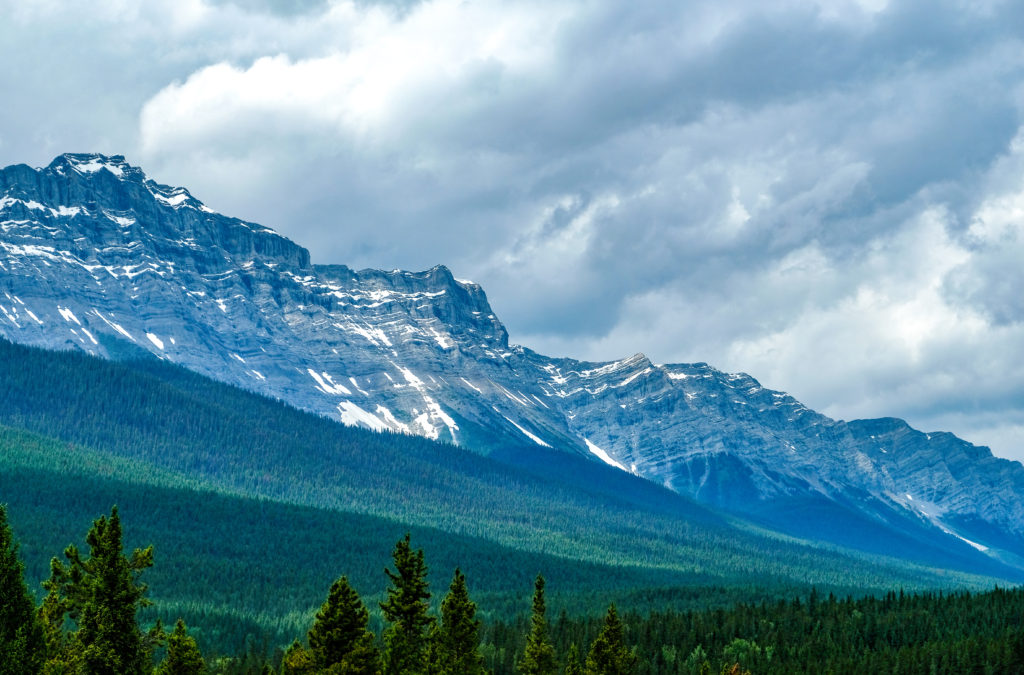
Banff National Park is located literally within the Canadian Rocky Mountain range
1. Peyto lake
On our first full day in Banff we had rather ambitious plans to be up by 5am and to make our way to Peyto Lake early in order to beat the summer tour bus rush. Unfortunately the snooze button turned out to be sleeper hit of the morning, and before we knew it 8am had crept up on us. We decided to take the hint, and after a leisurely breakfast at the lodge, we eventually got on the road later that morning ready to explore all the Banff had to offer.
The drive to Peyto Lake was 1.5hrs from Banff, and felt a lot shorter since we were busy admiring the scenic Icefields Parkway drive through the snow capped Rocky Mountains. This 240km drive that stretches all the way to the massive Columbia Icefield and it’s Glaciers is often considered to be one of the prettiest drives in the world. By the time we arrived at Peyto Lake, the rain had started coming down quite heavily, but it didn’t dampen our spirits as we headed out on the short hike to the best viewpoint of the lake.
The views of Peyto Lake were nothing short of stunning – although the clouds and rain obscured the peaks that we were hoping to see in the distance, the bright blue waters of the lake stood out like an artist’s deliberate brushstroke though the valley of green pines. The rocks by the edge of the viewpoint were rather slick due to the rain, but we still managed to get a few decent family shots together before the rain turned into a full downpour and got the better of us.
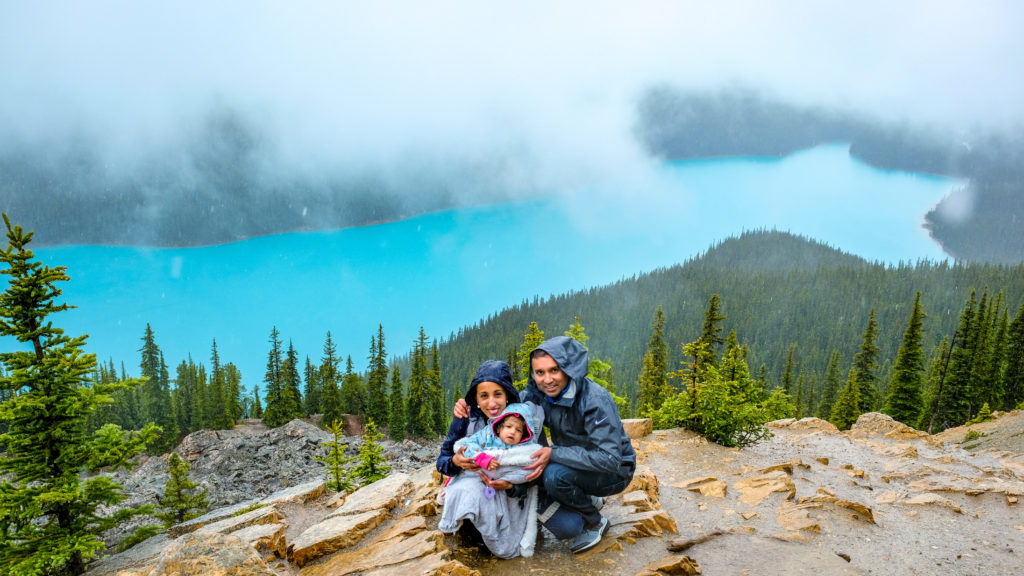
Stunning blue waters of Peyto Lake shining through the rainclouds
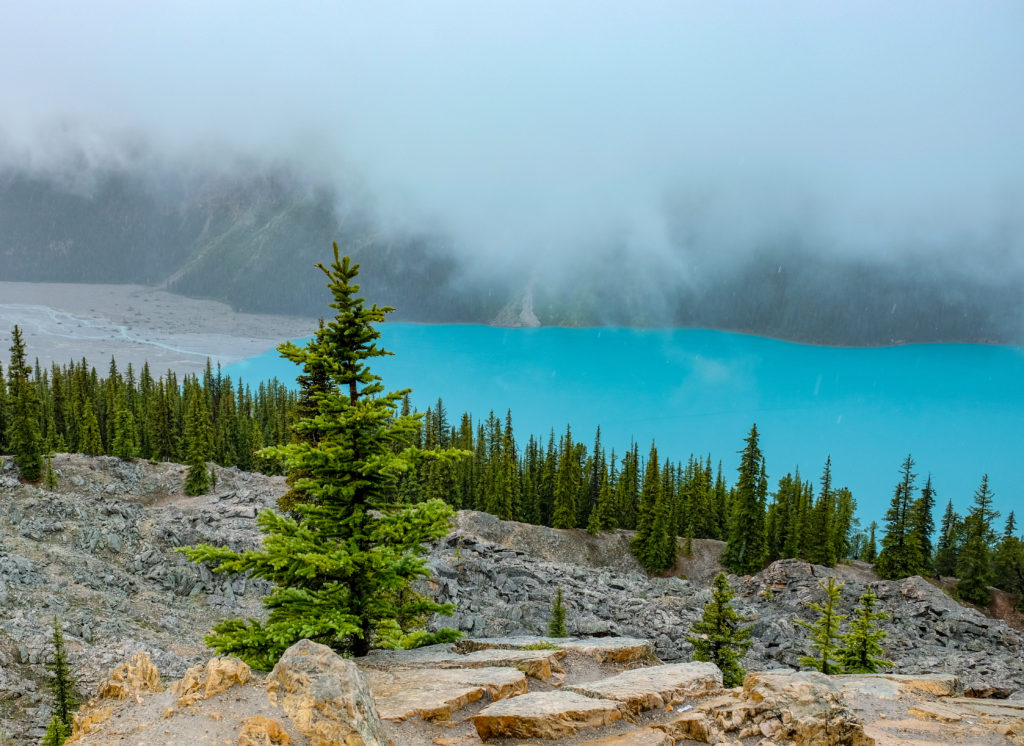
View of the Glacial melt stream that feeds Peyto Lake on the top left

The striking blue hues of Lake Peyto seemed to have been photo-shopped into the scenery!
2. Bow lake
We stopped at the Num-Ti-Jah Lodge on a whim while driving back from Peyto Lake in search for a quick bite. Besides the refreshing hearty soups we found at the lodge cafe, we were also rewarded with some expansive views of Bow Lake and the surrounding Bow Glacier and Crowfoot Glacier right from the steps of the lodge, albeit mostly obscured by clouds. We couldn’t resist wading a few steps into the shallow yet freezing waters of the lake and baby A really enjoyed getting out of the constraints of her car seat for a bit.
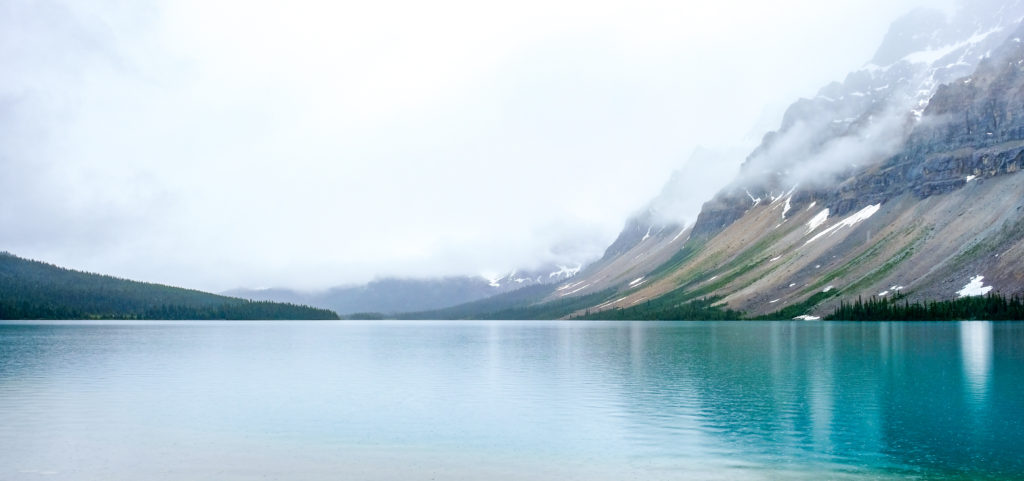
Crowfoot Glacier peeking through the clouds in the distance across Bow Lake
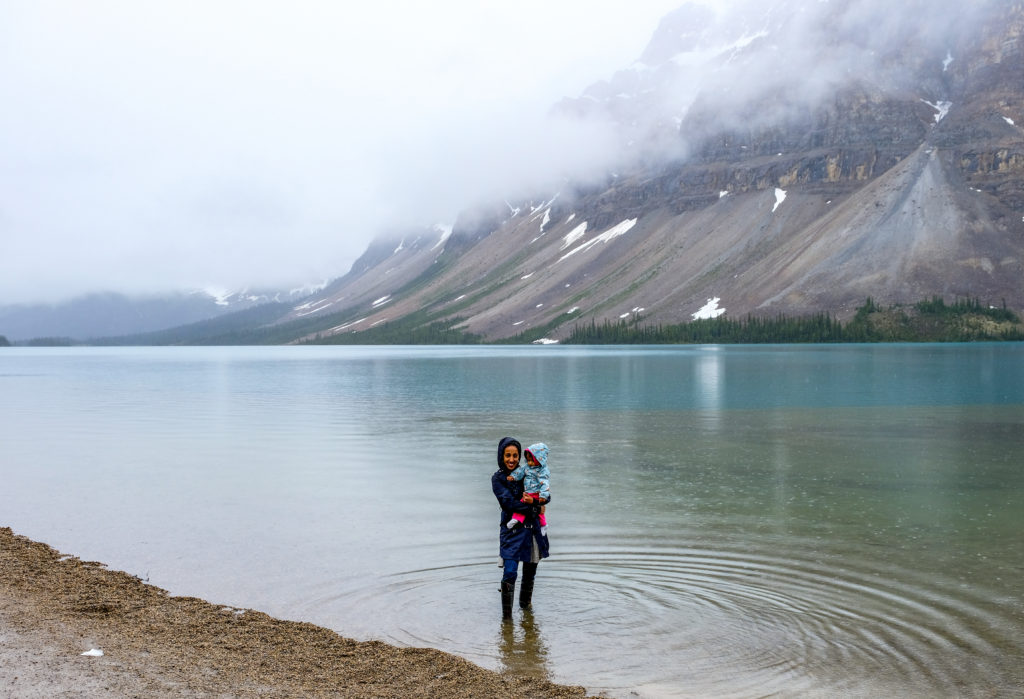
Shelly and Baby A test the frigid waters of Bow Lake
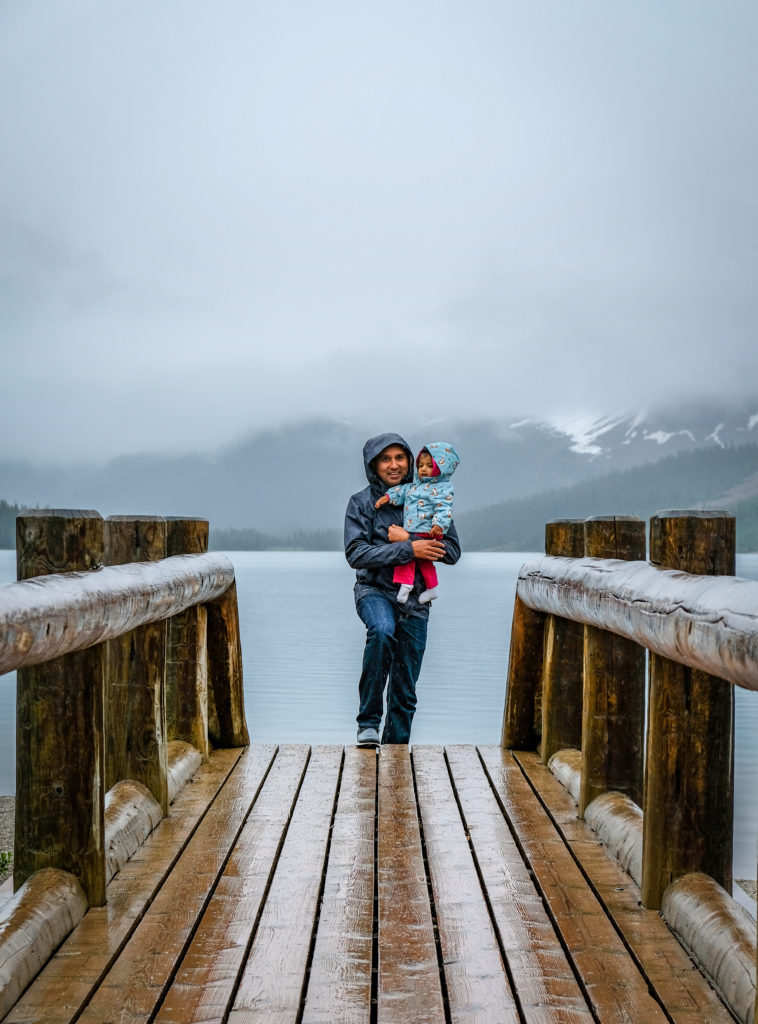
We came upon this wooden bridge across a tiny stream
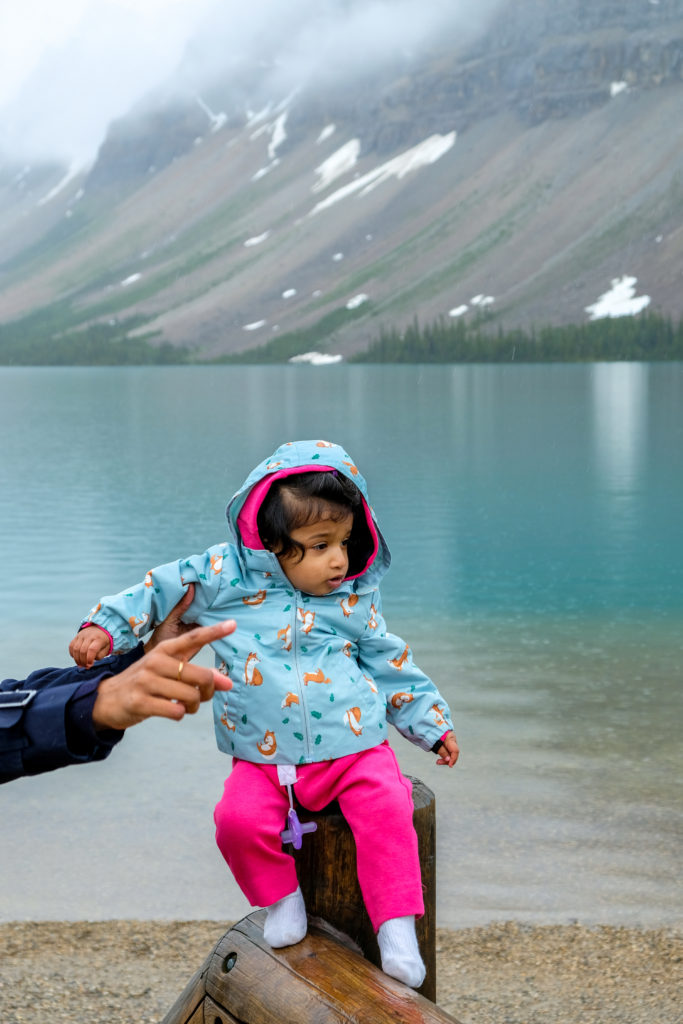
Really enjoying her perch on that bridge!
3. Banff Downtown
Situated along a bend in the Bow River, the charming downtown area of Banff is truly a resort village nestled within mountains. The town features some great restaurants, cafes and gardens with the backdrop of the Mt. Rundle and Mt. Cascade peaks in the skyline. Although the sidewalks would get super crowded during the peak lunch and dinner hours, we enjoyed strolling around this tiny town while taking in the views of the surrounding mountains.
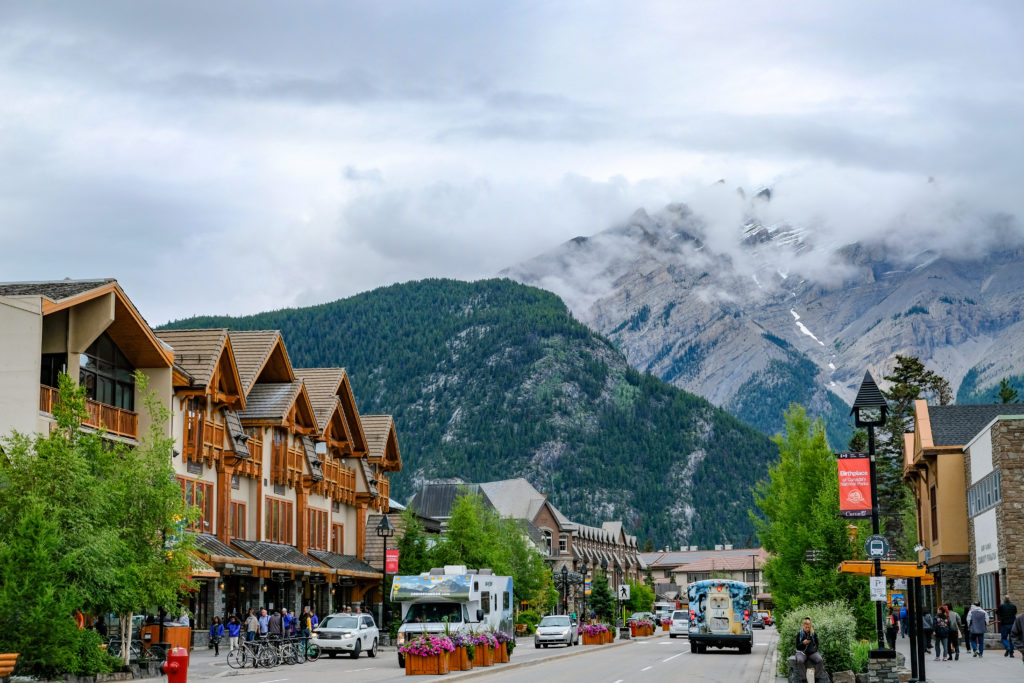
Mountains towering over the main thoroughfare of Main Street in Banff downtown
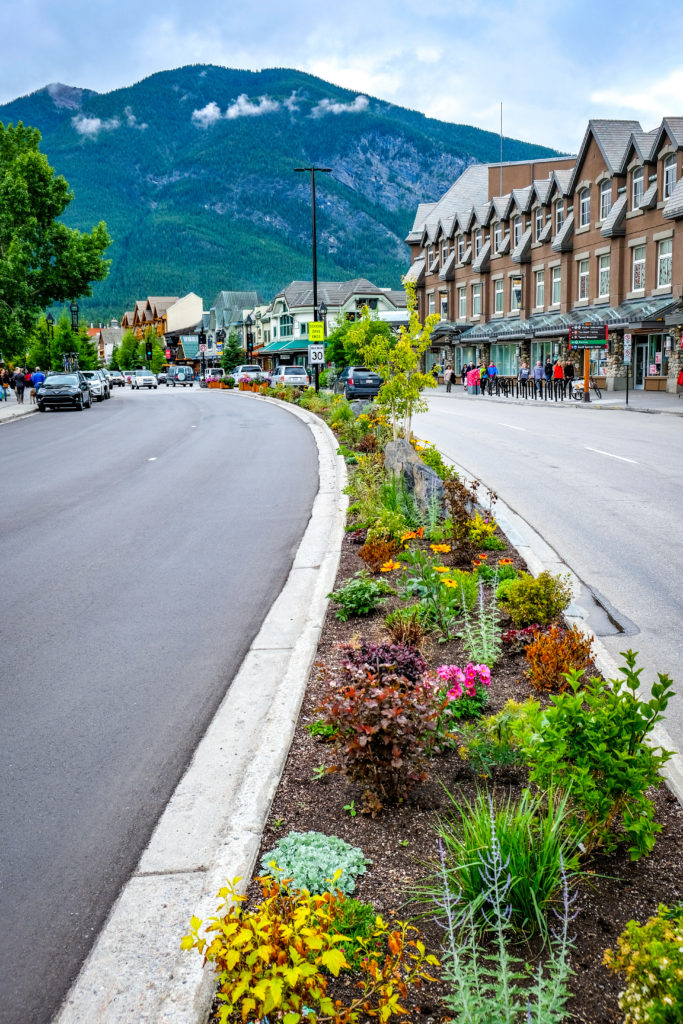
Colorful flowers dotting the center dividers
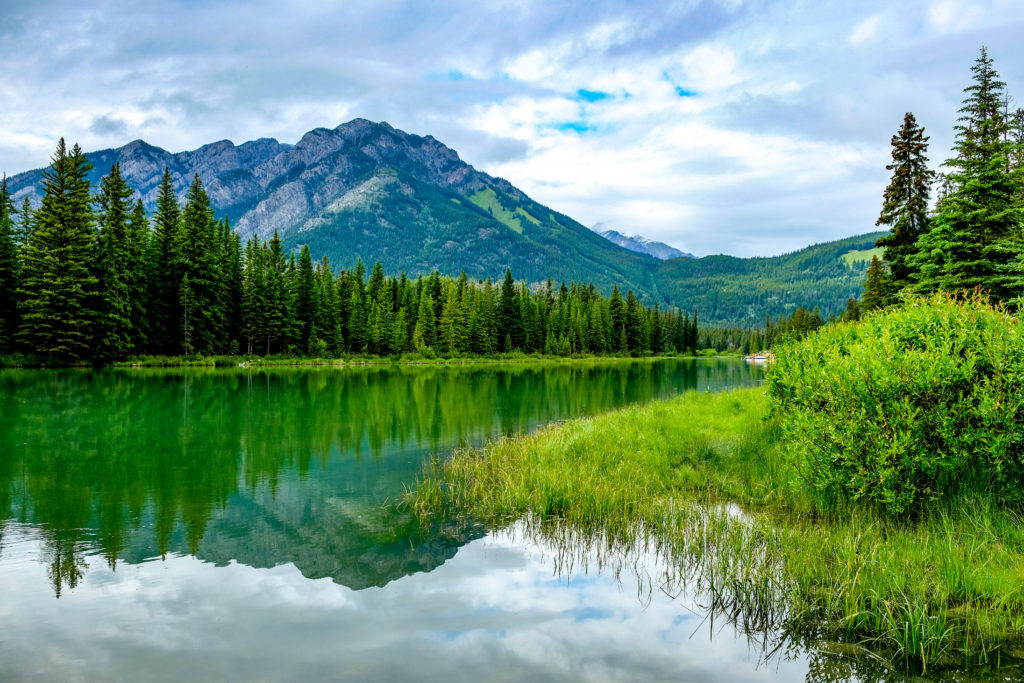
Picture perfect reflections of the mountains on Bow River that runs along the town
4. Johnston Canyon
On our second day, we were up bright and early, ready to go chasing some waterfalls in Johnston Canyon.
After the previous day’s serene and calm lake waters, the rushing waters of Johnston Creek’s rapids and waterfalls were in sharp contrast. The creek cuts though narrow canyons hewn into the sheer rock faces on either side, and offers multiple waterfalls, pools and view points along an easily accessible suspended walkway and trail.
The rather small parking lot gets filled up quick, so we decided to beat the crowds and got to the Canyon before 7am. Besides ample parking, getting there early also meant we were rewarded with an almost empty trail when we started our hike.
The main attraction here are 2 sets of waterfalls – a lower falls and an upper falls, which make for a moderate difficulty 5km round trip hike with about 130m height gain. The metal elevated walkway till the lower falls was fairly flat enough to let us and push Baby A’s stroller for most of the trail. The hike up to the upper falls was a different story though, and the often steep climb forced us to take turns hoisting A in her baby carrier.
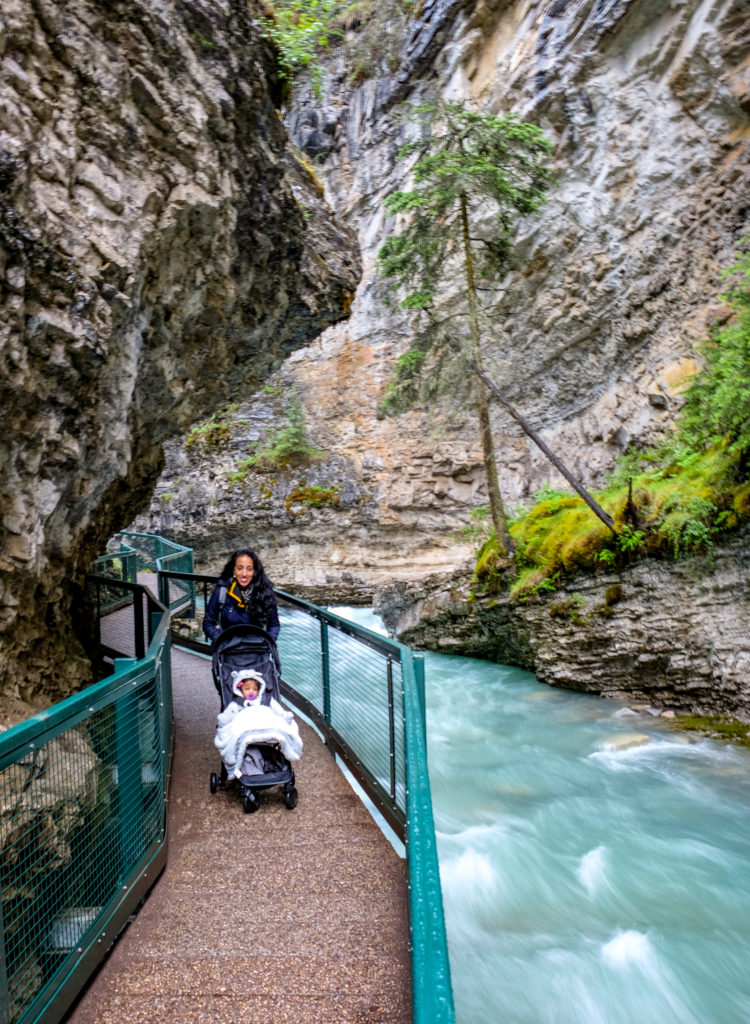
Our hike / stroller walk started out relatively easy…
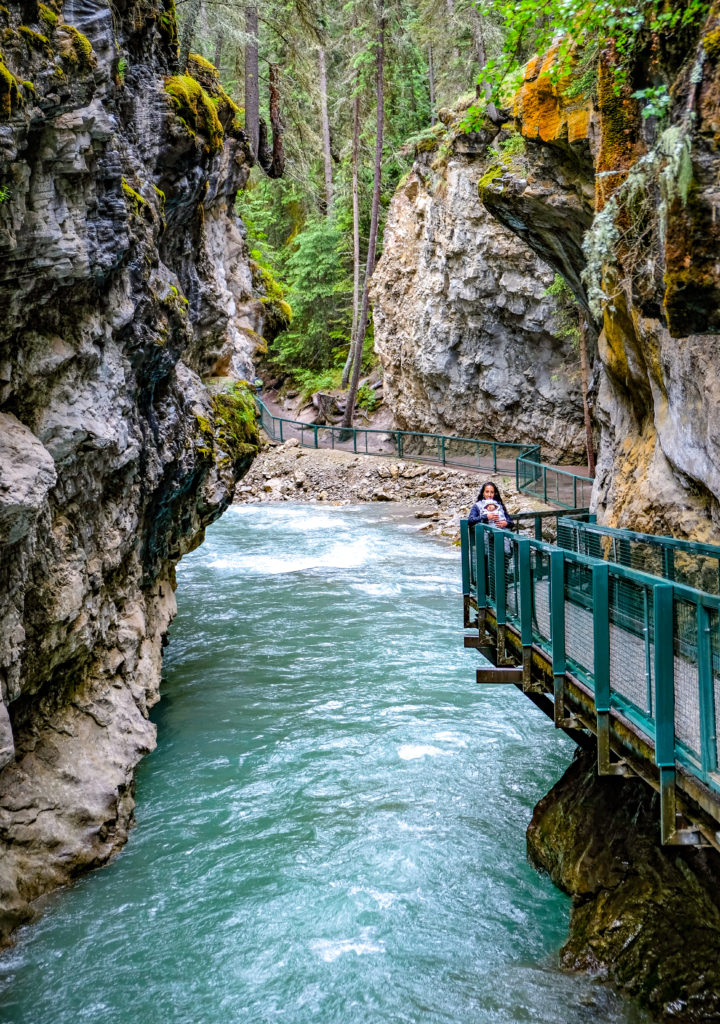
…and we practically had the whole trail to ourselves.
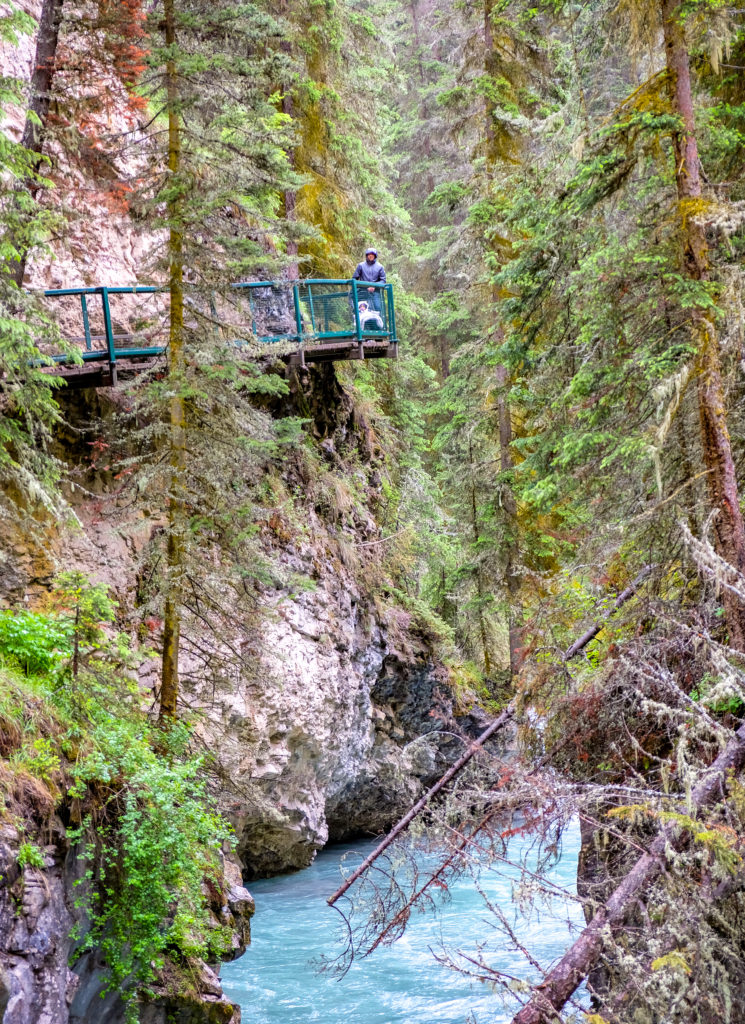
Halfway to the Lower Falls
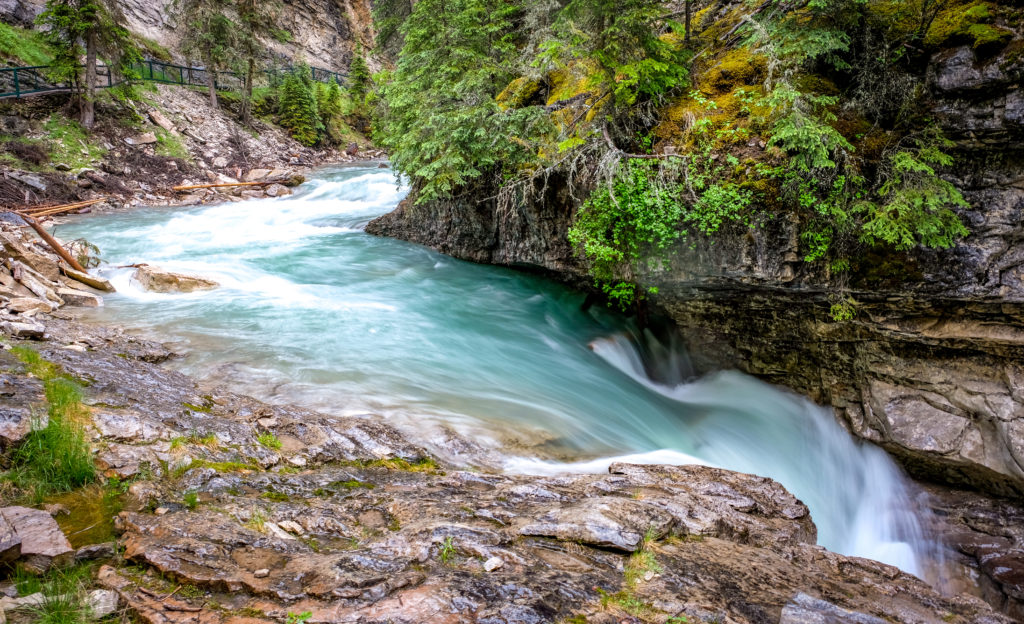
Icy cold waters of the Johnston Creek making their way through the canyon
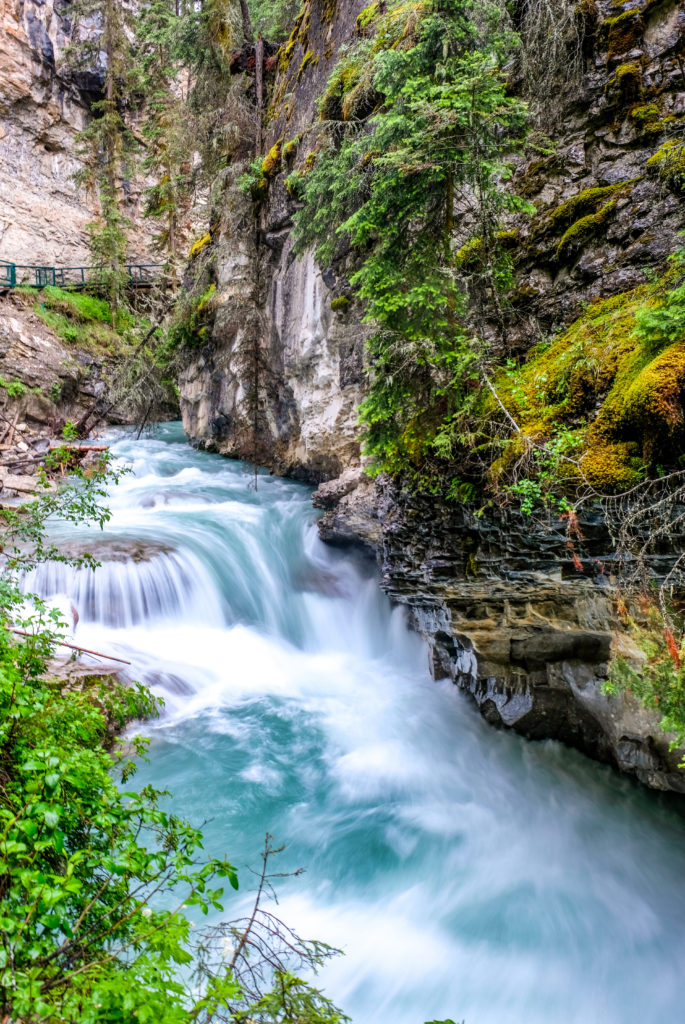
The moss and fern covered canyon walls contrast against the blue rushing waters
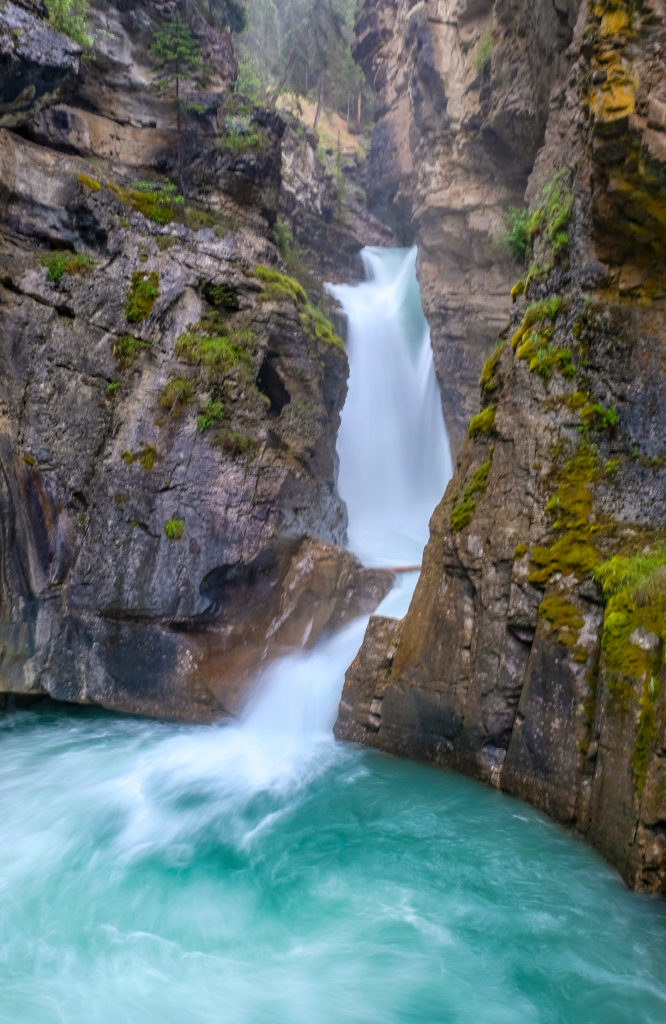
The Lower Falls of Johnston Canyon
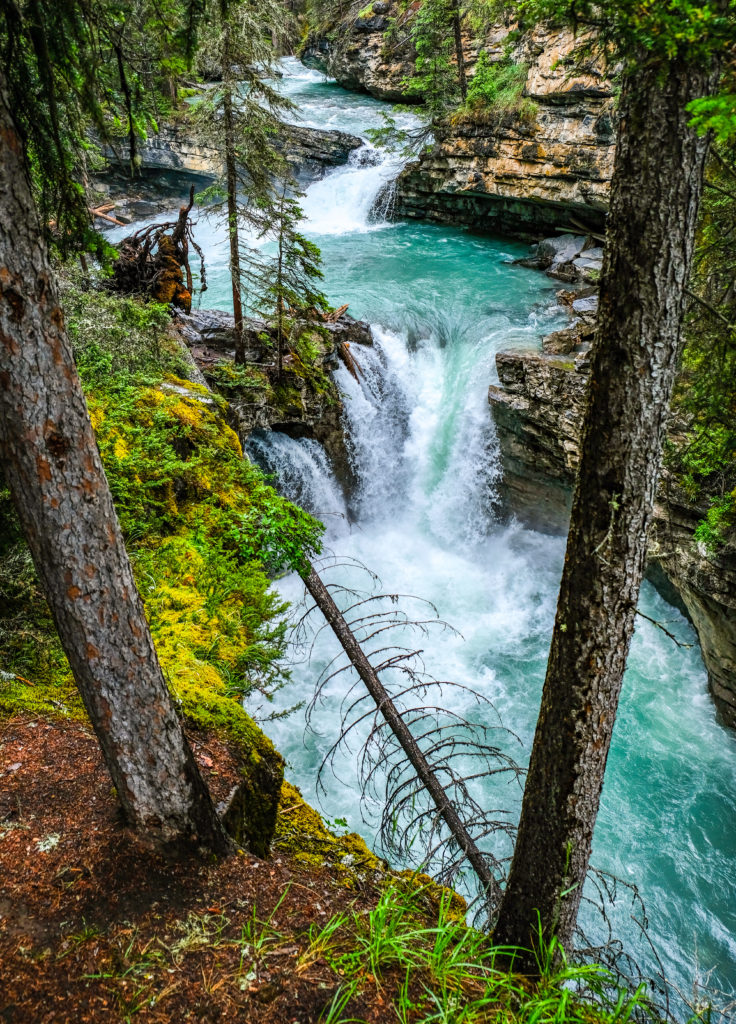
Multiple waterfalls and pools to enjoy along the hike up the canyon
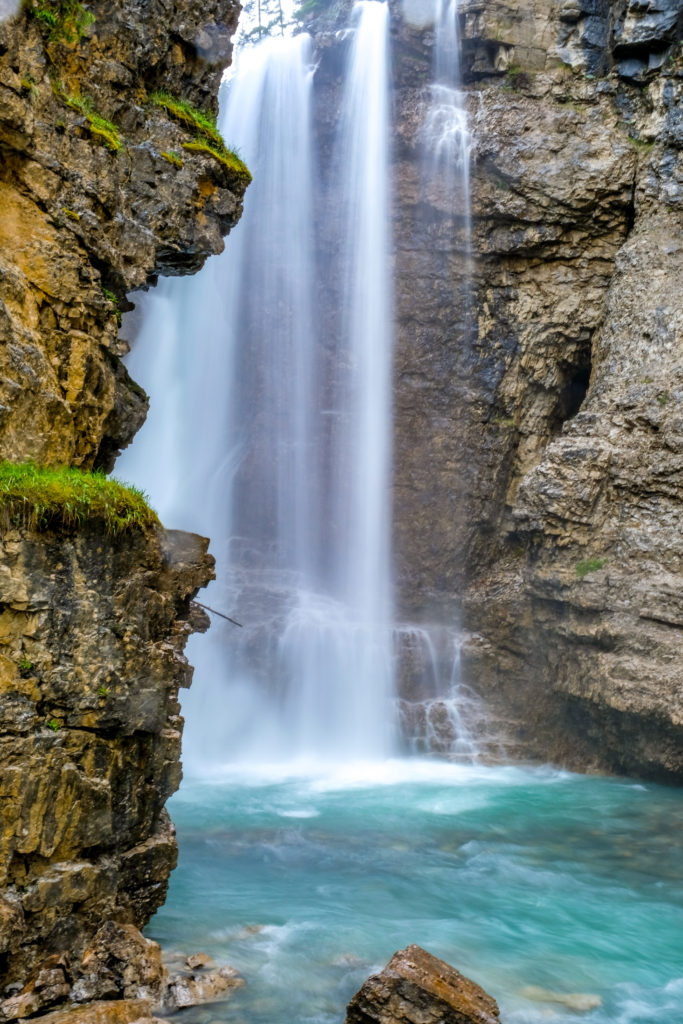
Getting drenched by the mist from the Upper Falls
5. Cave & Basin National Historic Site
This is where it all began for Banff National Park. In 1883 three railway employees stumbled upon the cave and thermal springs within, and immediately realized that there was a fortune to be made if they commercialized the site. After many a dispute over the next couple of years about ownership, the federal government eventually stepped in and established the Banff Natural Reserve here, which would be the precursor to become Canada’s first national park.
Our first introduction to the site was a short historical and informational exhibit in the entry lobby, but a strong Sulphur smell quickly led our noses to the main cave and hot mineral spring within. The cave itself was rather small and stuffy, but still worth a few minutes of exploring – before our nostrils surrendered to the thick pungent scents and we hastily made our way out for some welcome fresh cool air.
Once outside we enjoyed the sight of the emerald colored outdoor pool, then we watched a short historical video in the adjoining theatre before our stomachs started rumbling for lunch.
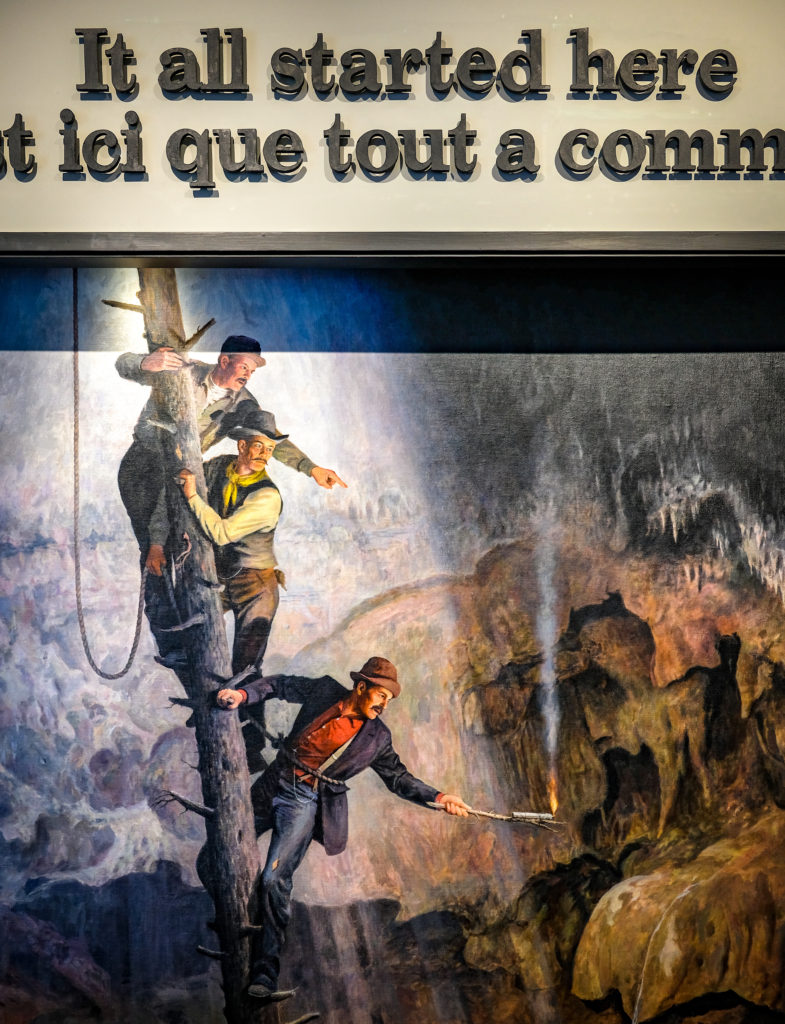
Exhibit about the discovery of the thermal springs by the 3 railroad workers
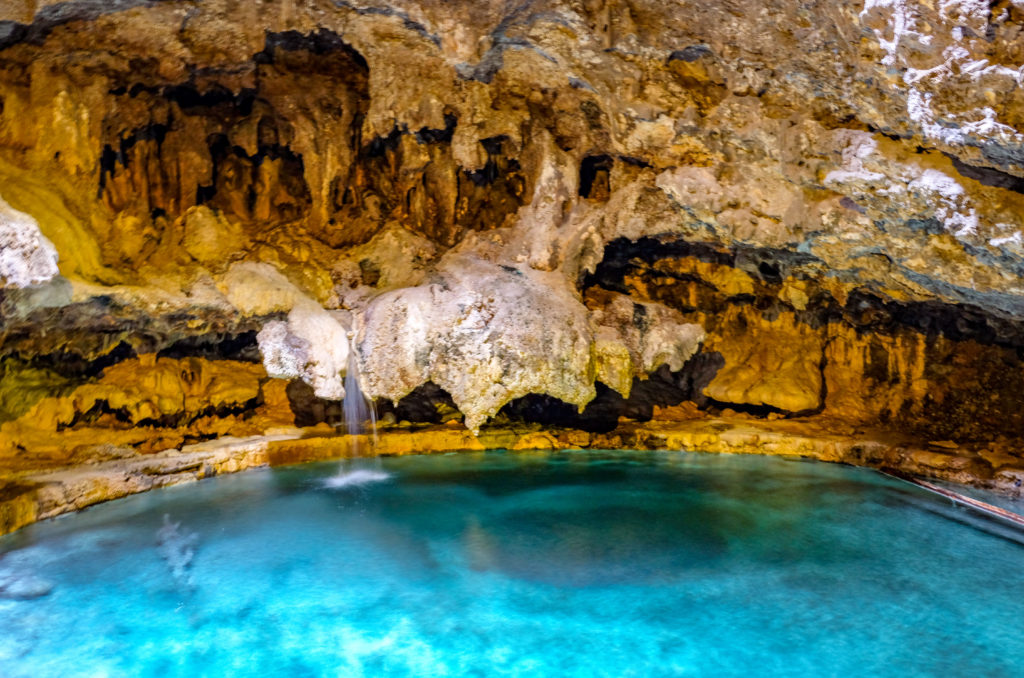
The actual cave and thermal springs. Can you smell the sulphur?
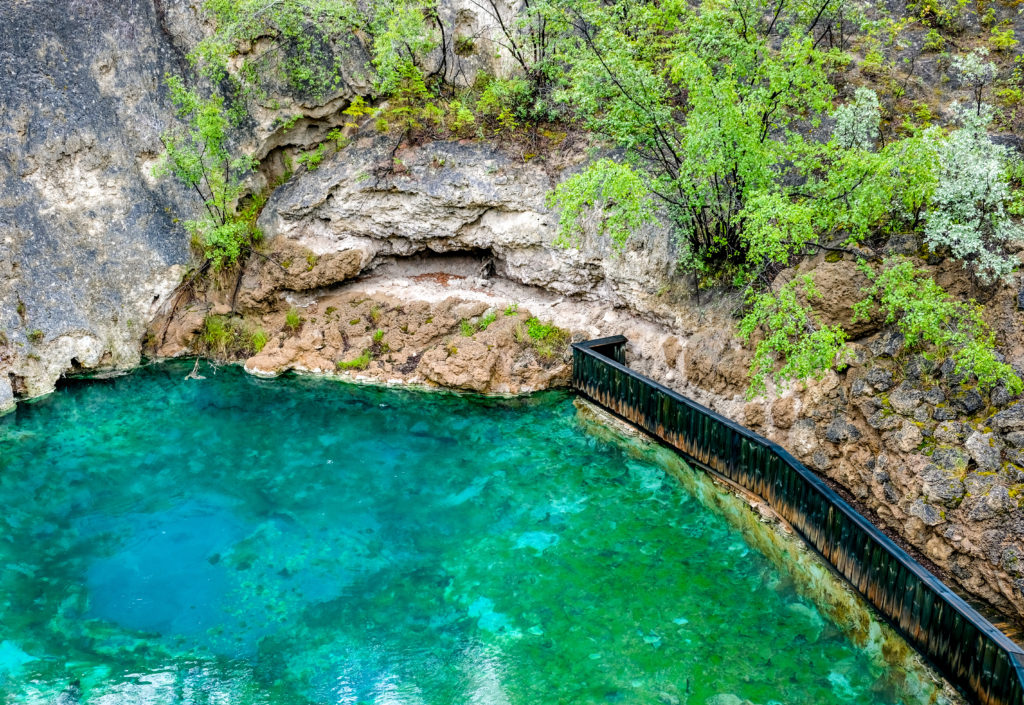
Emerald colored waters of the outdoor pool
6. Lake Moraine
Visiting Lake Moraine was probably the main inspiration for our Banff visit, after seeing countless pictures of the blue lake in travel magazines and our friends’ social media feeds.
In order to ensure we got a spot at the tiny parking lot, we made another early start on our third day – leaving Banff at 6am and eventually making it to Lake Moraine jut before 7am. The lot was surprisingly already full, but we managed to snag a spot after a short wait. From the parking lot, we took a short hike up a rather steep rockpile trail to get to a better vantage point.
Once we reached the top, we were amazed by the picture postcard sight that greeted us – the cobalt blue waters of Lake Moraine perfectly framed by floating clouds, mighty snow capped mountains and lush green pine trees. The stunning blue of the lake water is caused by the rock flour/silt brought down by melting glaciers, and the particles are so tiny that they float in the water and affect the way light is absorbed and refracted off the water surface – hence creating such a vibrant blue hue. In fact, the sight of the cobalt blue water almost seemed fake, as if it was the result of a massive blue paint spill. Lake Moraine is situated in The Valley Of The 10 Peaks, but unfortunately our view of the peaks was obscured by some stubborn clouds. Nonetheless, we spent about an hour at the vantage point, taking in the captivating views of the water and capturing our pictures, before it was time to head to our next stop at the nearby Lake Louise.
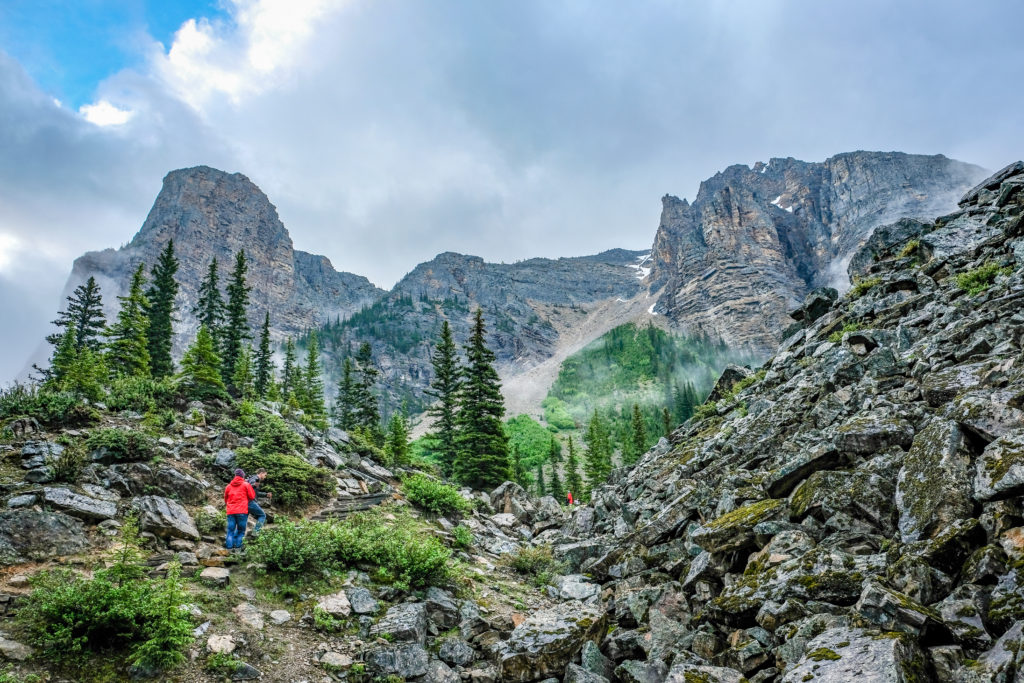
Short hike up the Rockpile trail to get to the upper viewpoint of the lake
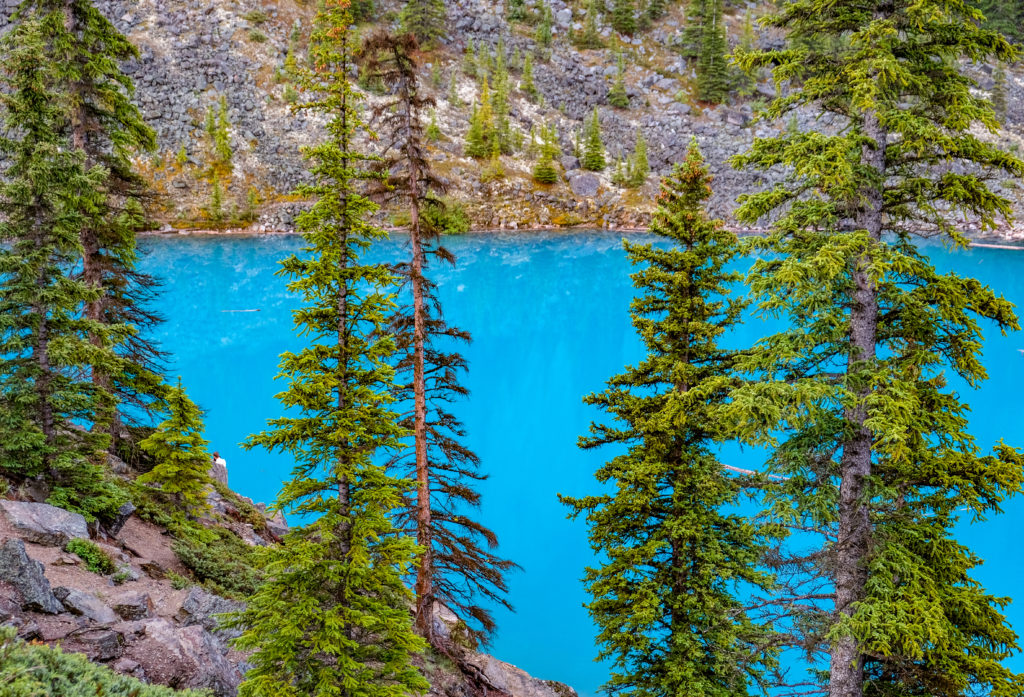
First glimpse of the lake…is that blue real??
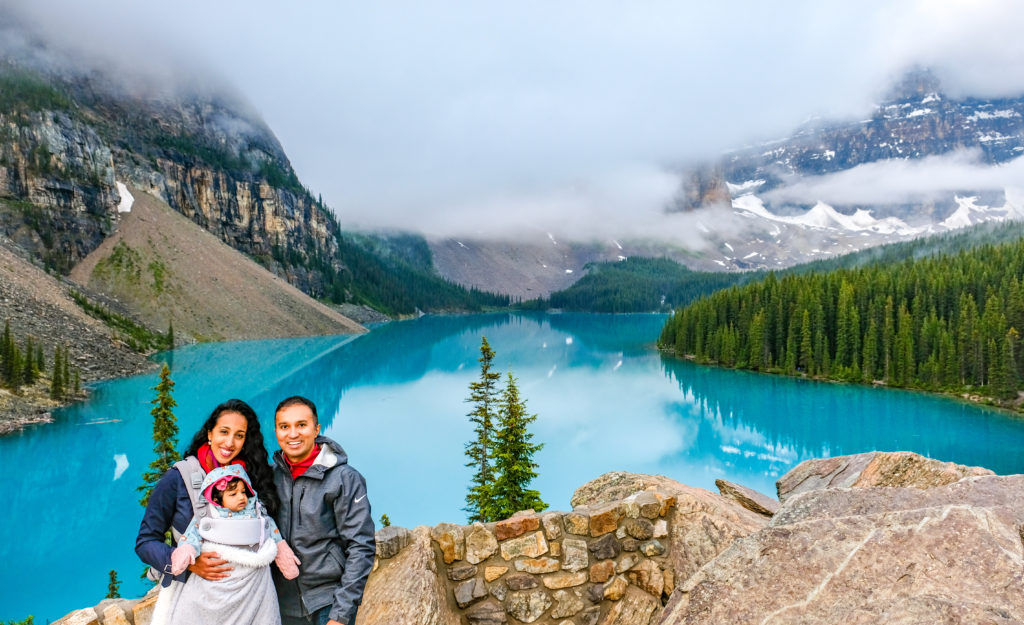
Stunning cobalt blue waters of Lake Moraine
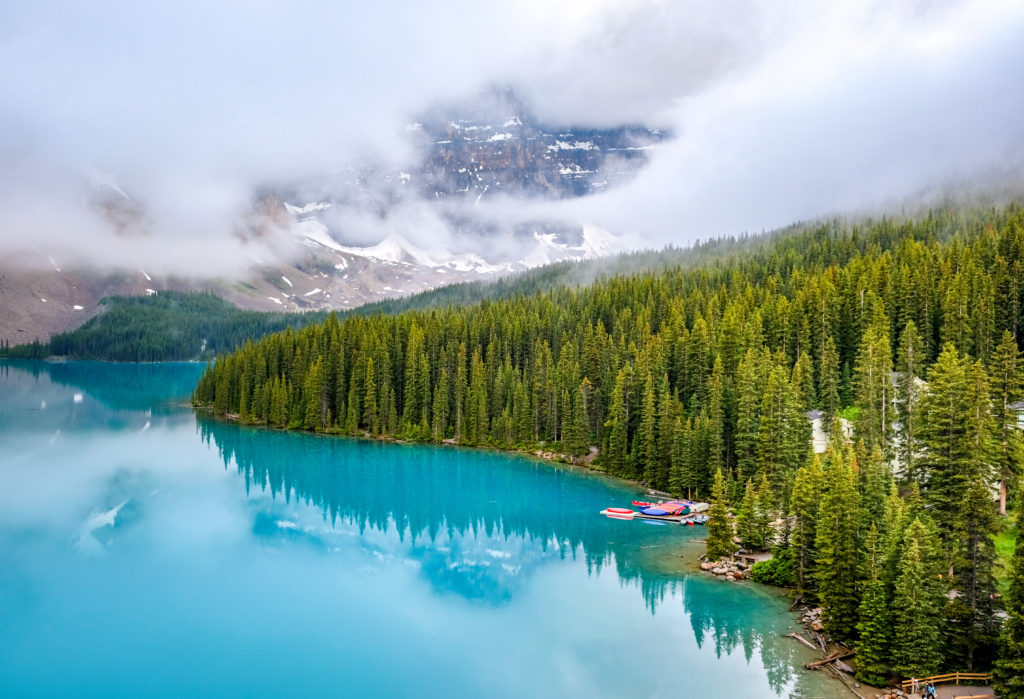
Kayaks are available for rent at the shore to experience the waters from up close
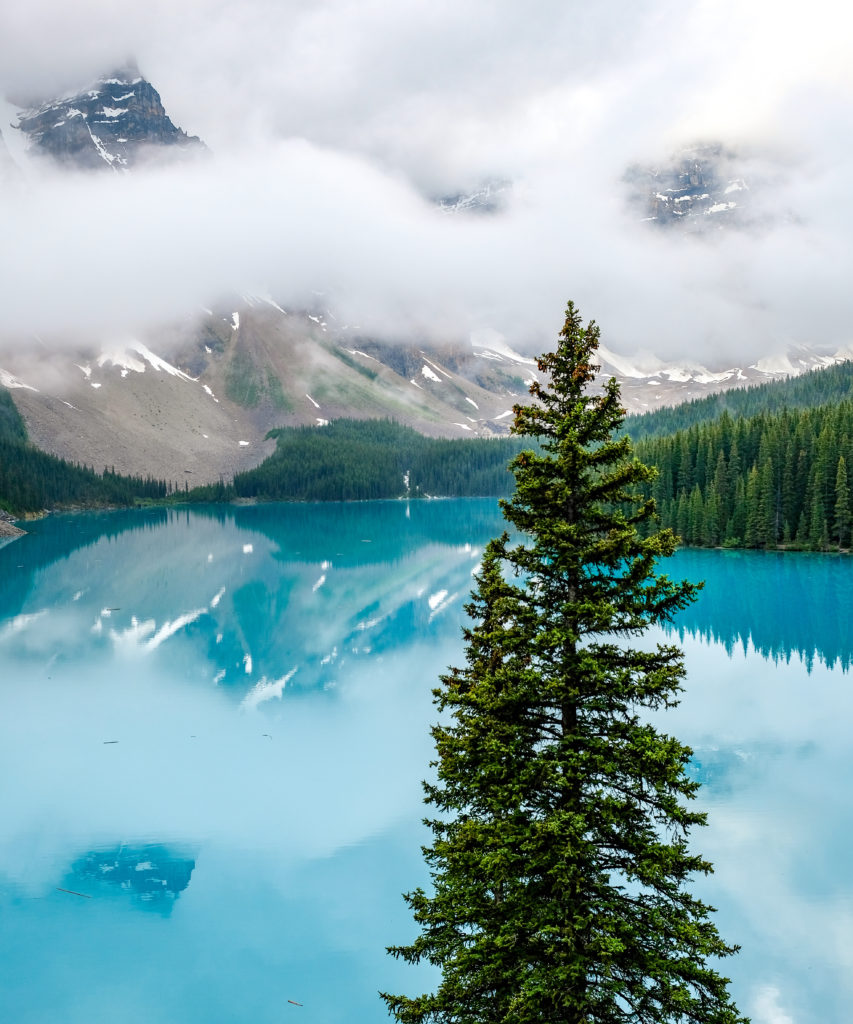
Green, blue and white
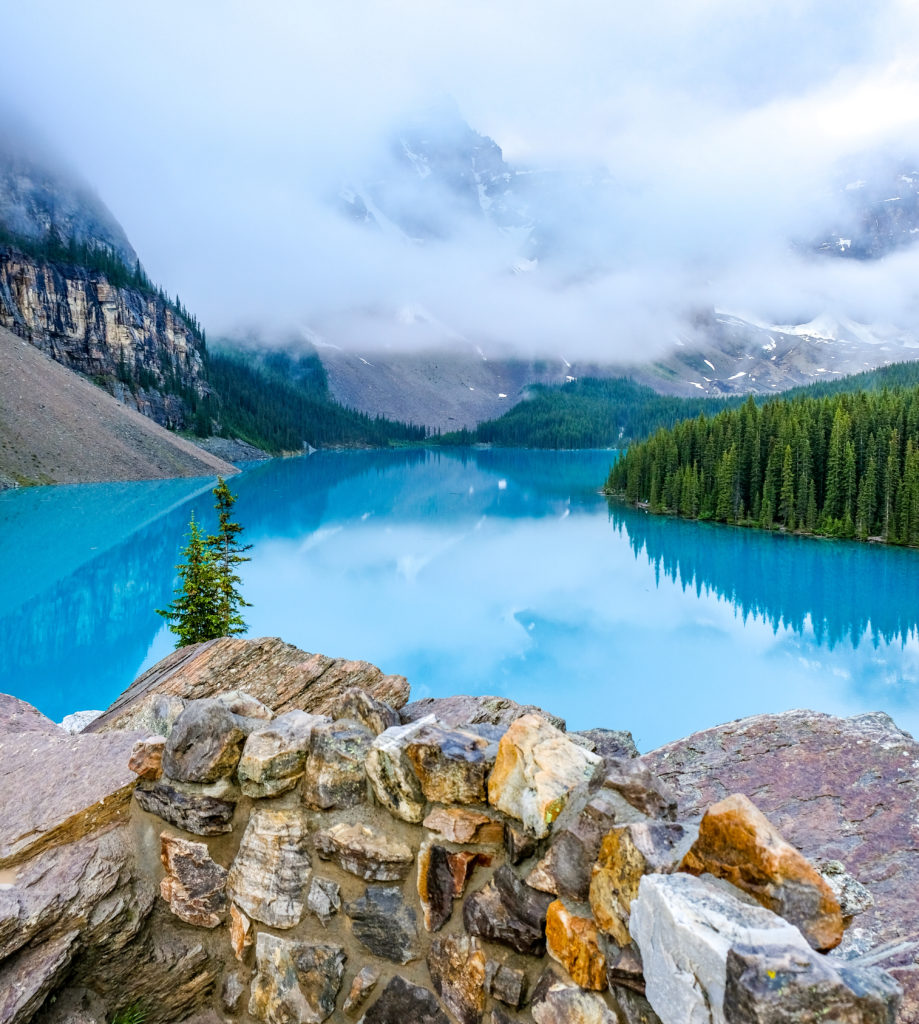
The thinning clouds gave us a sneak peak of the snow capped peaks in the distance
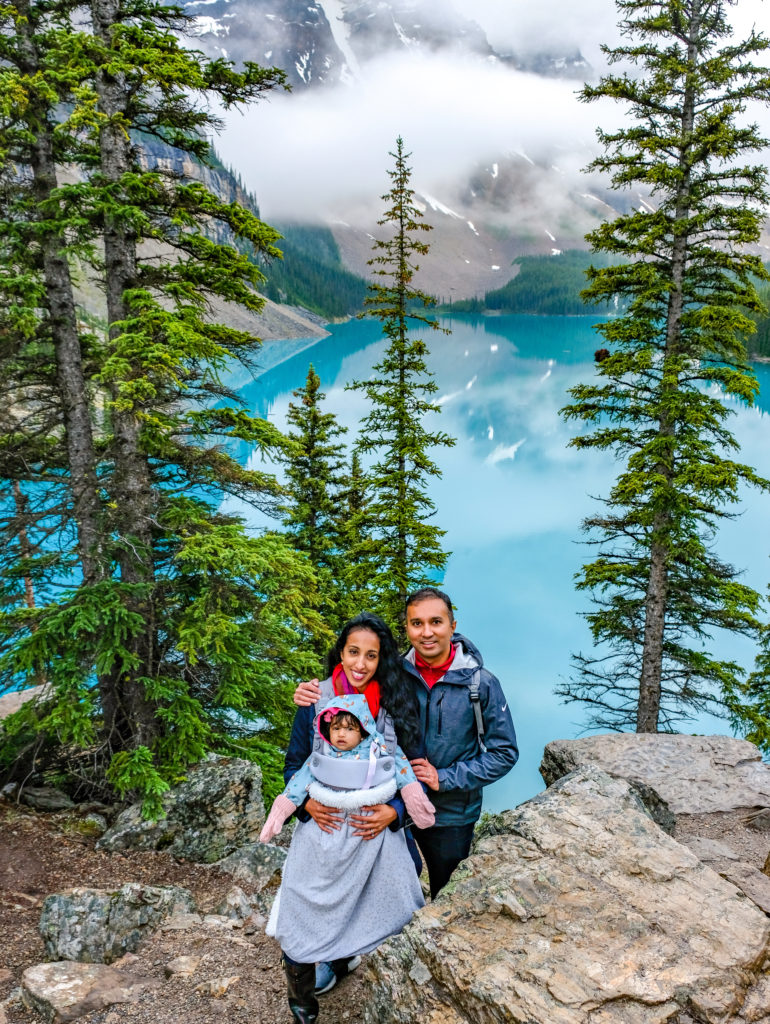
One last family pic before we had to bid adieu to this stunner of a lake
7. Lake Louise
By the time we got to Lake Louise after 8am the main lot was already full, but thankfully the overflow parking early still had a few spots, and it was a quick walk to the lake shore. Lake Louise looked almost chrome green compared to Lake Moraine – since it has more glacial rock flour floating within its waters hence more blue light wavelengths are absorbed and more green reflected.
Although it was not the clear and sunny view we had hoped for, the low mist hanging over the still cloudy water added an eerie otherworldly feel to the scenery. The many tourists paddling the waters in their bright red kayaks were a dash of color punctuating the green heavy view.
The historical Chateau Fairmont hotel is situated right along the lakefront, and we popped in for a quick breakfast since we had not had a chance to eat before our early morning departure. After getting fed and full on some scrumptious scones and breakfast sandwiches, we were ready to explore more of the lakefront.
We took a 5km hike along the lake shore to enjoy Lake Louise from multiple viewpoints. Although the misty rain threatened to turn into a full blown downpour many times, we were lucky to be blessed with dry weather for our entire hike. Baby A loved being bundled up in the chilly air as well, and decided to take a long nap instead.
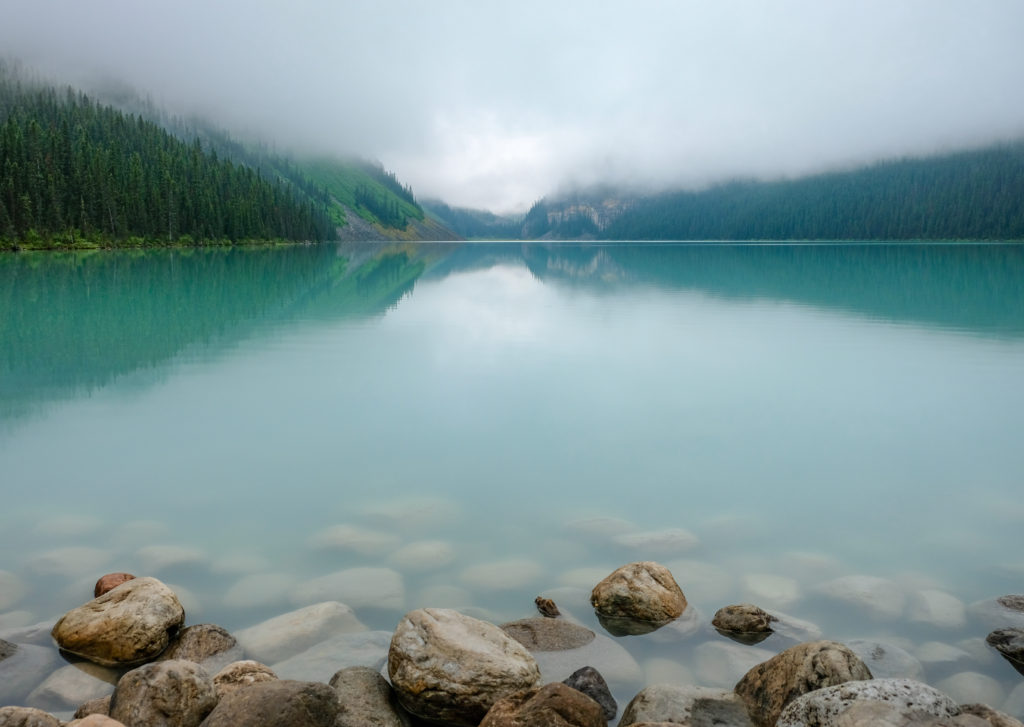
An eerie and dreary looking Lake Louise shrouded in mist
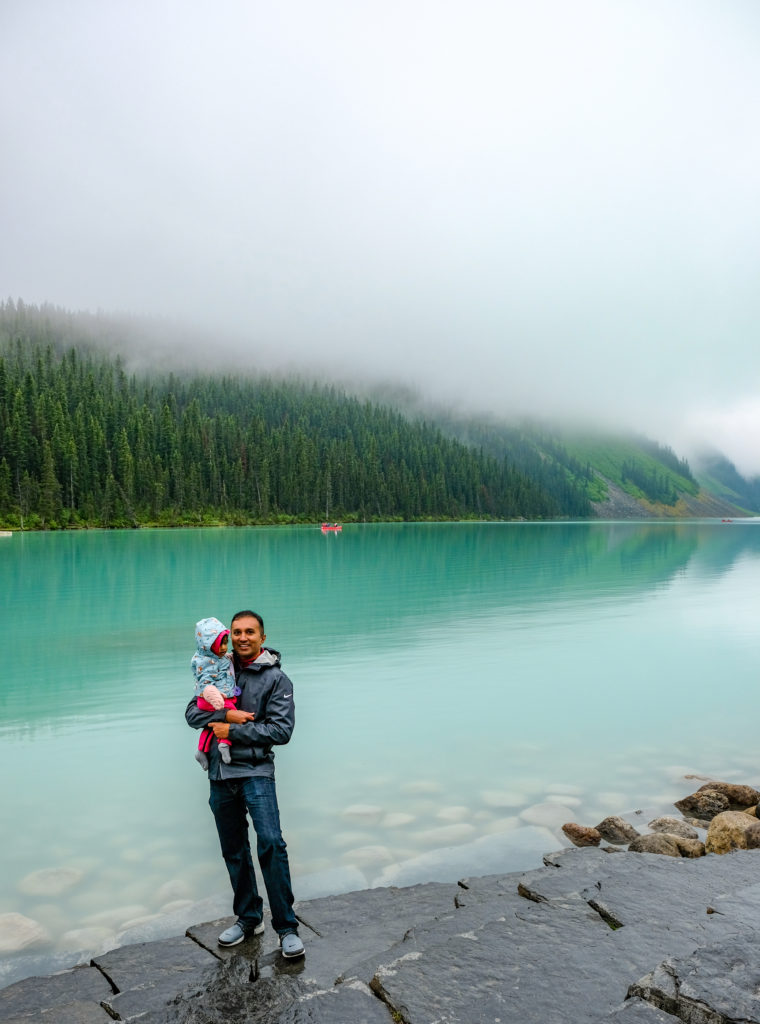
This is summer weather?
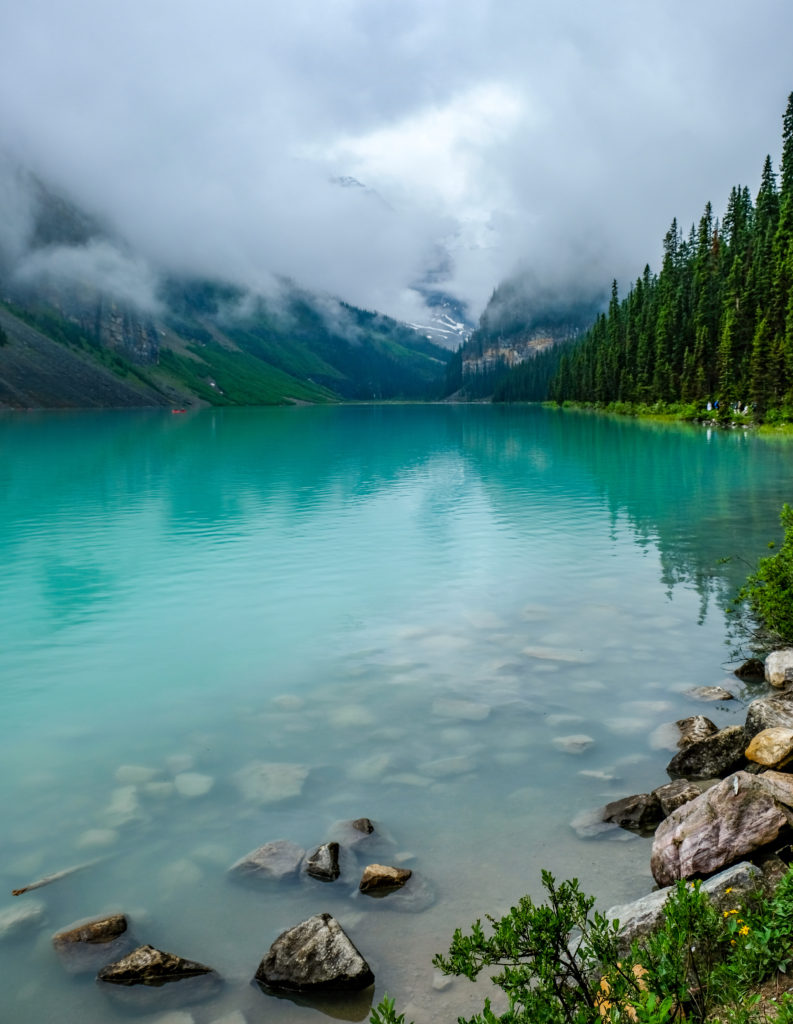
Morning mist and clouds hanging over the waters
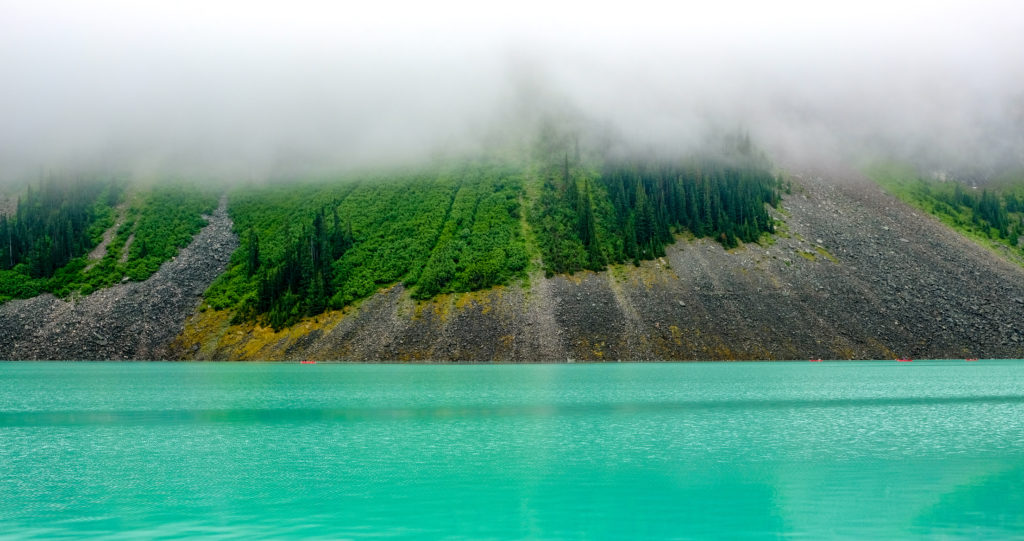
The waters of Lake Louise look a lot greener than the bright blues of Lake Moraine

Maybe when Baby A is older we’ll come back for a kayak outing on Lake Louise as well

Almost at the end of our hike along the lake shore
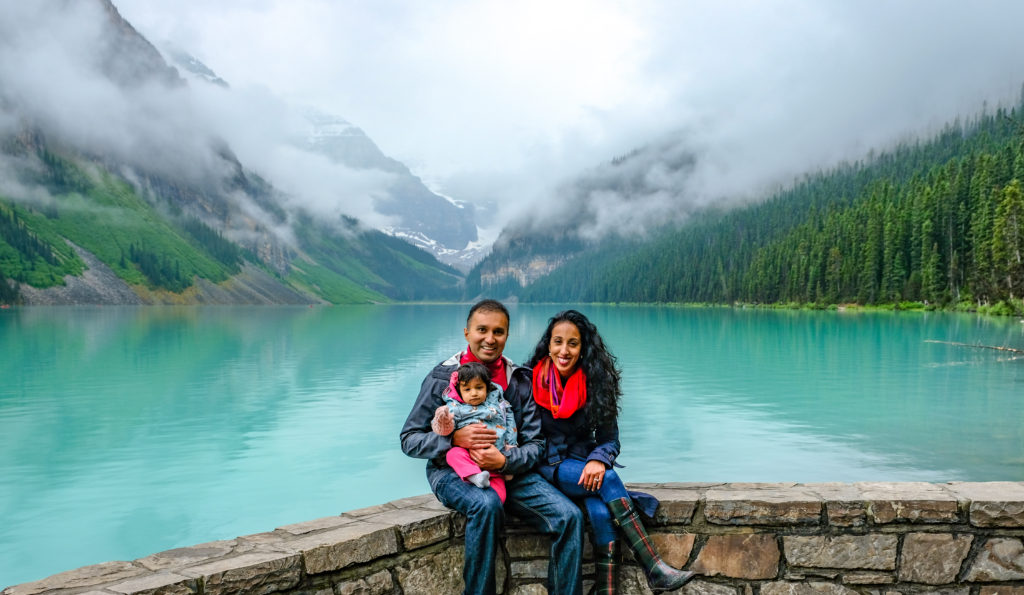
Made it back in the nick of time before the heavens opened
8. Lake Minnewanka
This was our last Lake for the trip, and where we finally managed to get a few hours of non stop clear and sunny weather. Lake Minnewanka offered us some great views of the serene waters framed by the nearby mountains and peaks. The Lake interestingly is situated on the site of an old dam, which submerged settlements that are now only visible still to scuba divers willing to brave the frigid waters.
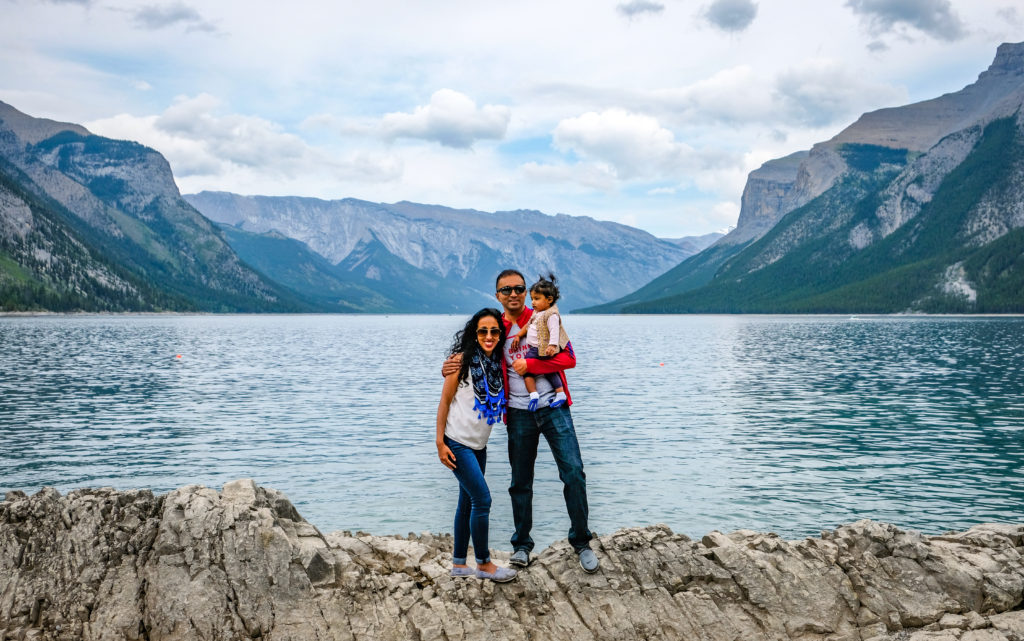
Savoring some welcome sunshine by the edge of Lake Minnewanka
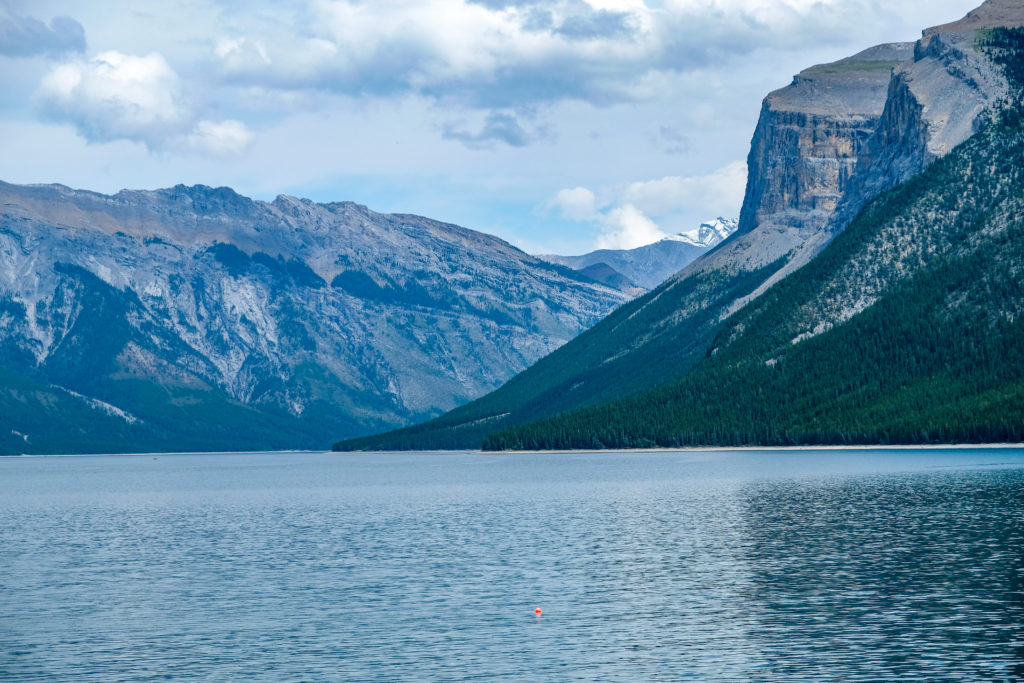
The lake waters didn’t seem as bright blue compared to the other lakes we visited
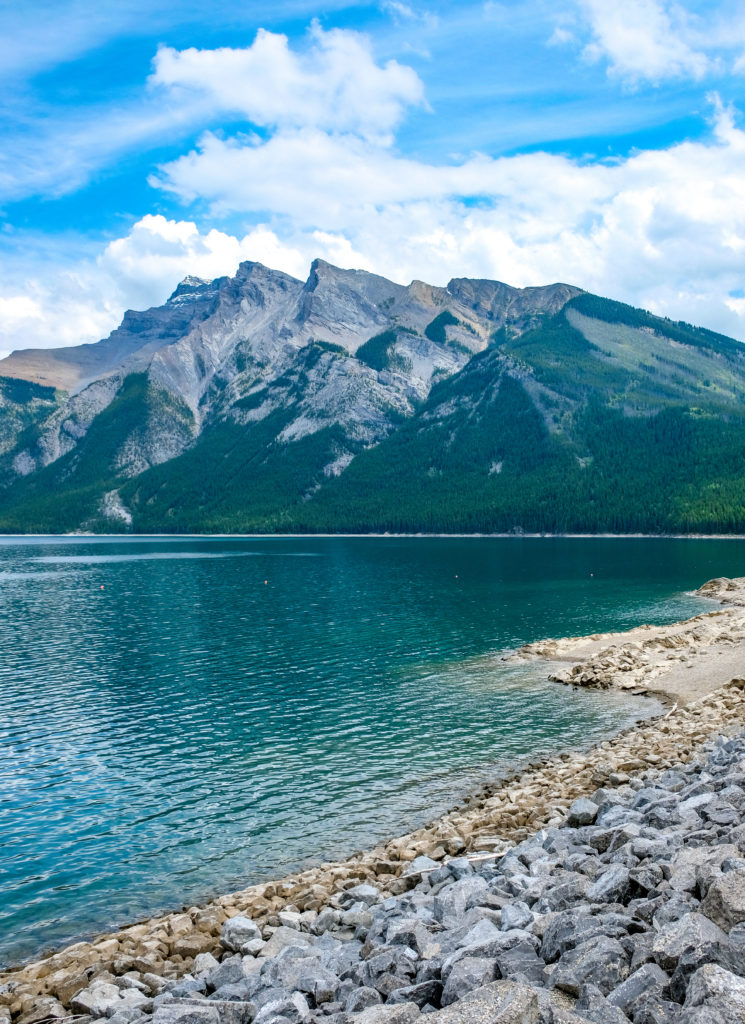
Rocky shoreline of Lake Minnewanka
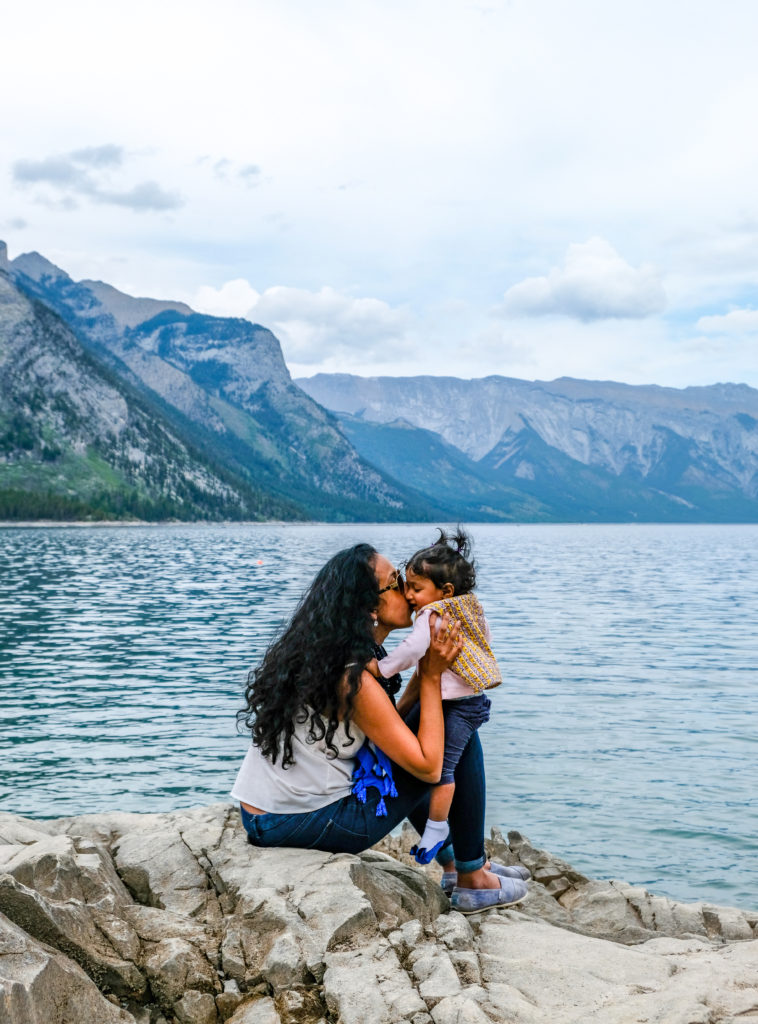
Smooches to wrap up our lake visits
9. Bear sighting
On our way back to Banff from Lake Louise, we were cruising along the Trans-Canada Highway 1, when out of nowhere a sudden traffic jam materialized. Turns out, there was a Grizzly Bear cub hanging out by the barrier along the highway, and multiple vehicles had pulled over to take a closer look. As dutiful tourists we obliged as well and quickly stopped by the roadside to watch the little bear cub play around on the grassy mound.
Besides being an awe inspiring nature, Banff National Park is also a wildlife preserve that is home to Bears, Elk, Bison, Deer and other wild animals. Warning signs reminded us of the unlikely threat of Bears on the trails each day, but luckily we didn’t run into any on our hikes. Gladly our only sighting was from behind the relatively safe confines of a fence out in the open by a highway roadside.
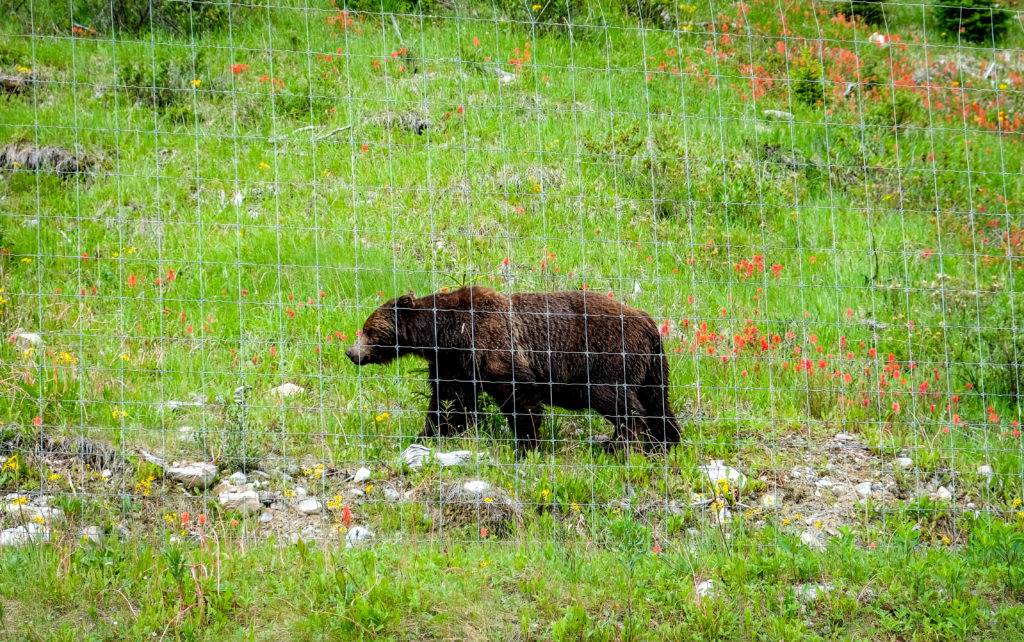
Grizzly Bear cub casually strolling by the park fence alongside the highway
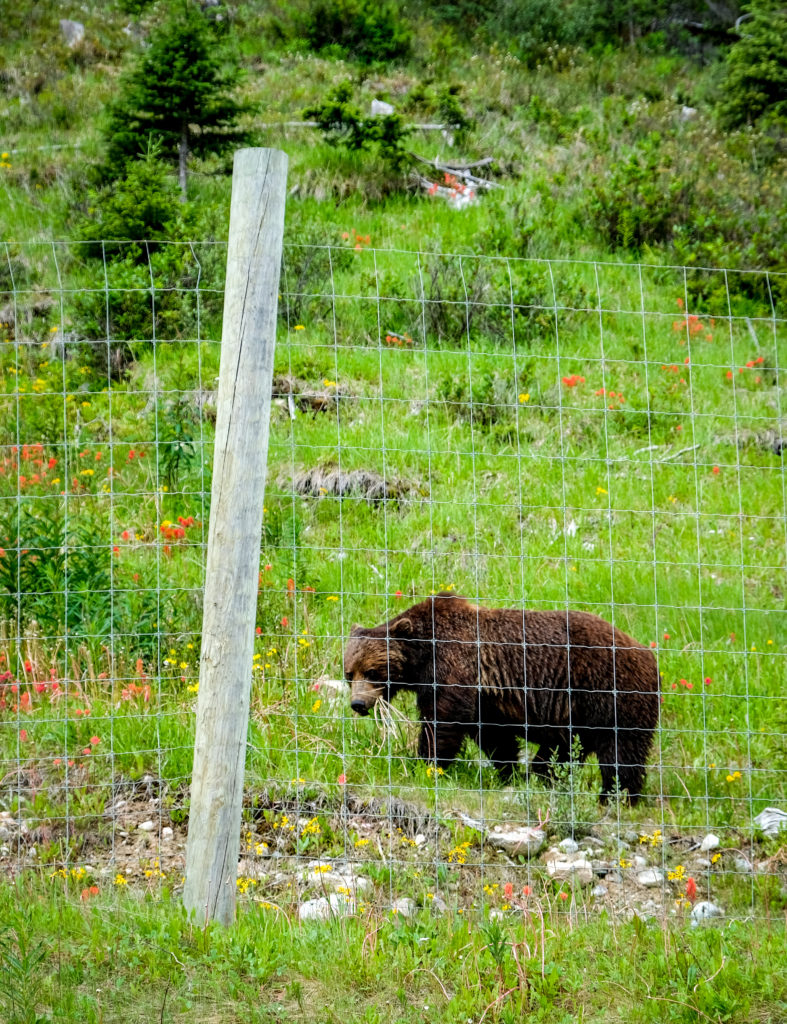
Vegetarian bear?
Eats & Drinks
For such a tiny town in a remote park, we were pleasantly surprised by the high quality of restaurants and cuisines available in downtown Banff. Almost every one of our meals was amazing – here’s a snapshot of some of our favorite restaurants/cafes:
Grizzly House
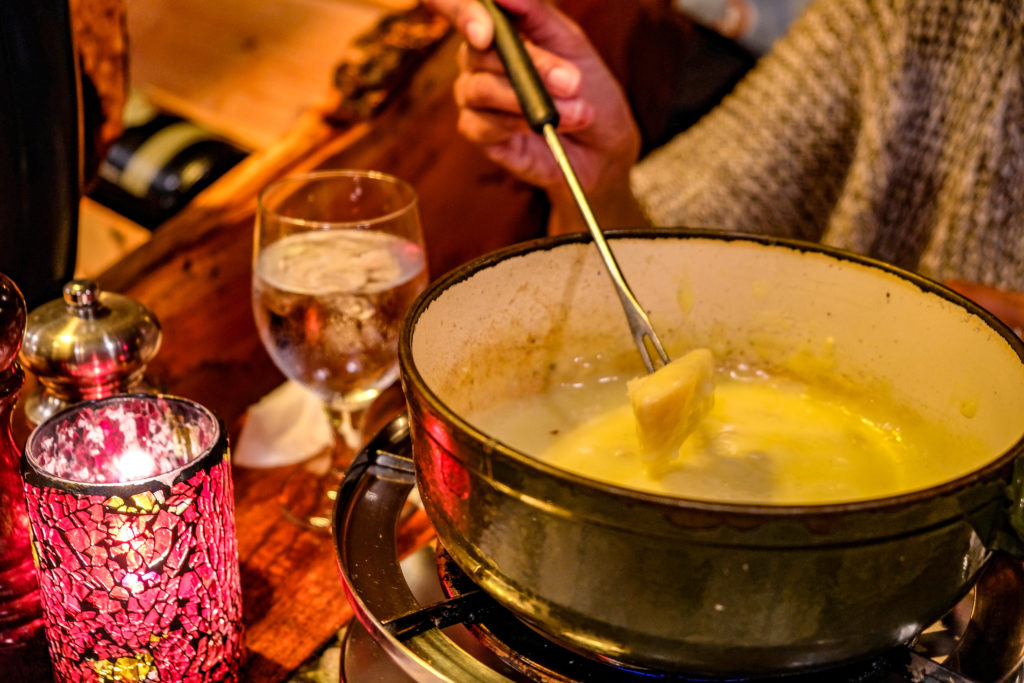
Decadent fondue and exotic steaks
Banff Brewing Company
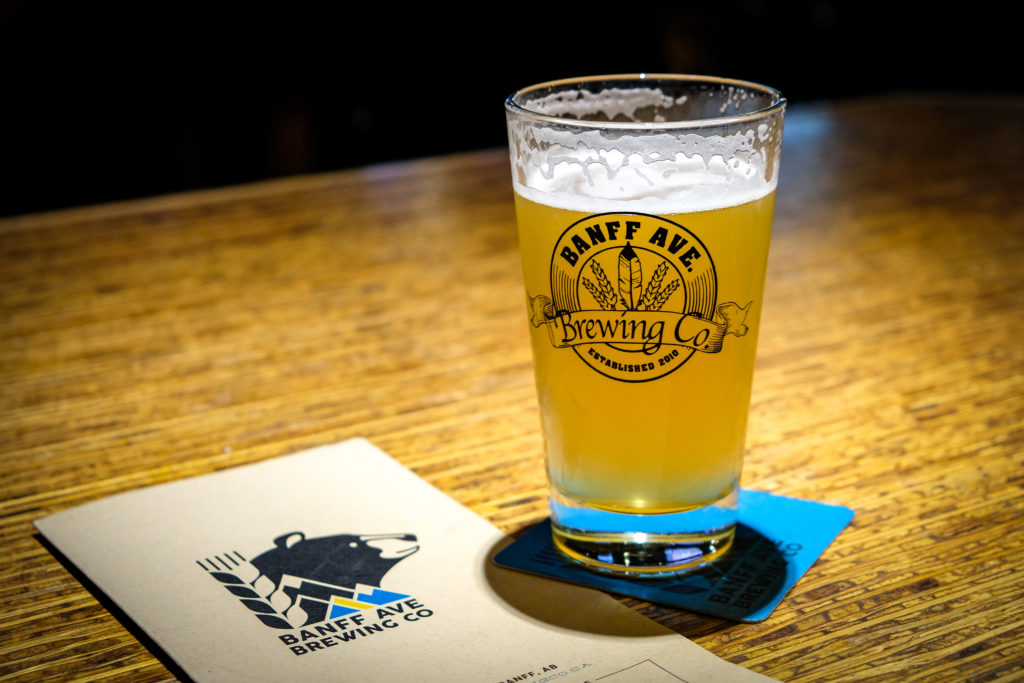
Best place for an icy cold pint and some poutine after a day of hiking
Wild Flour Bakery
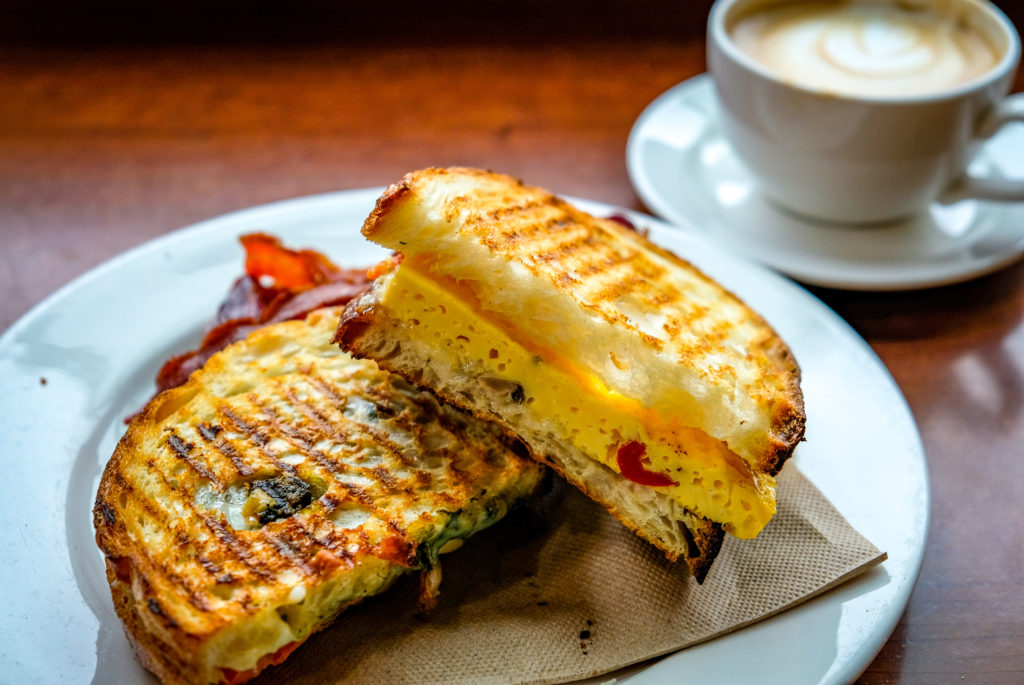
Hearty breakfast sandwiches and freshly baked scones
Saltlik
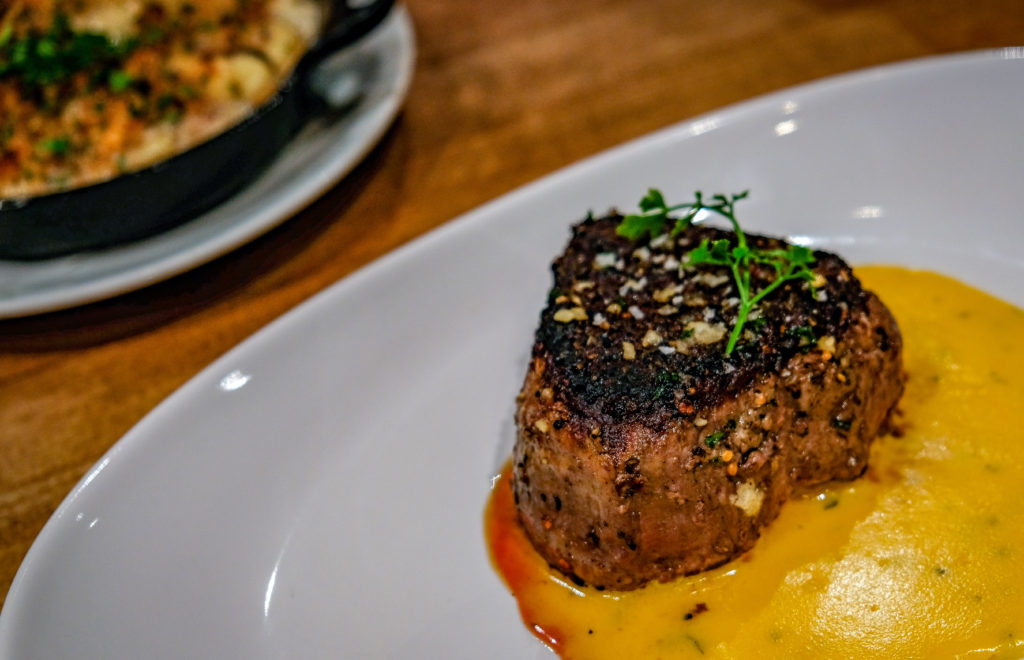
The best steaks in Banff! Make sure you order the truffle mac’n’cheese as a side
Beavertails
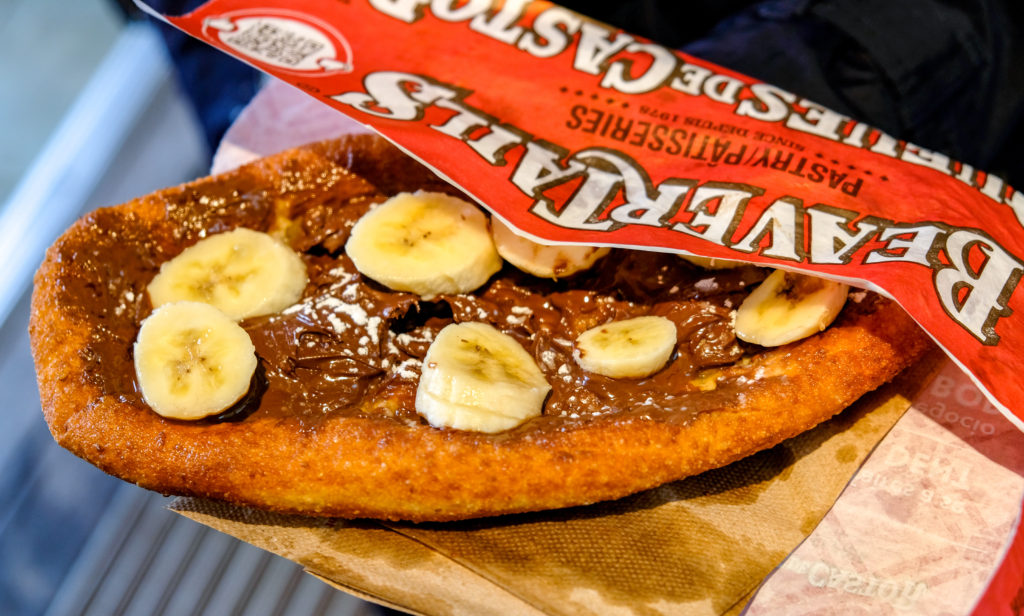
Local fried dough pastry dessert

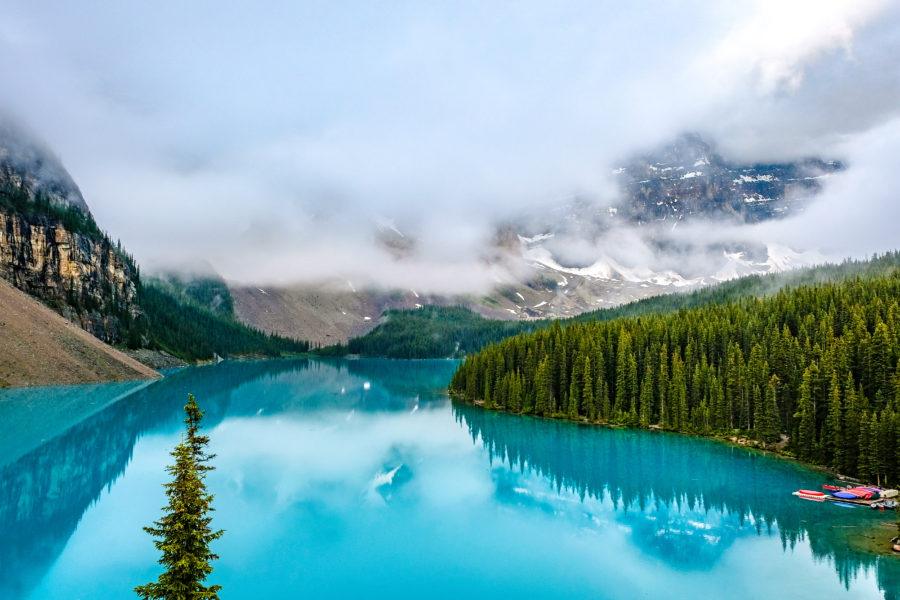
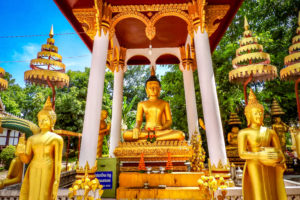
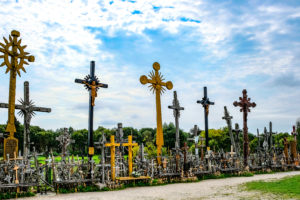
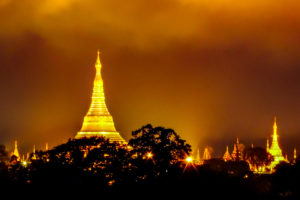




Leave a Reply
Please share your comments below!